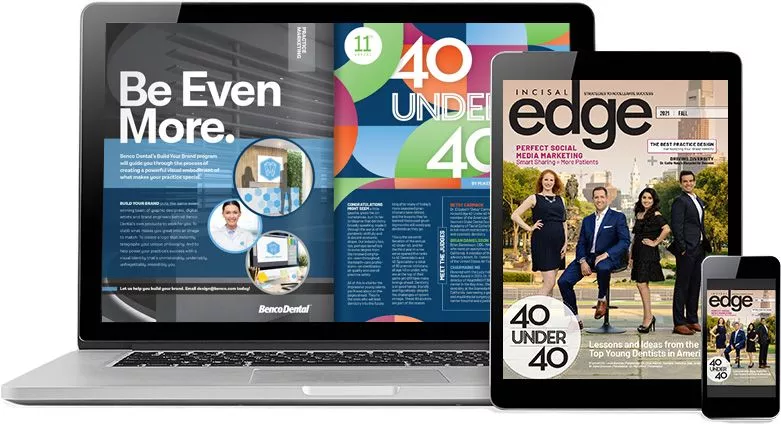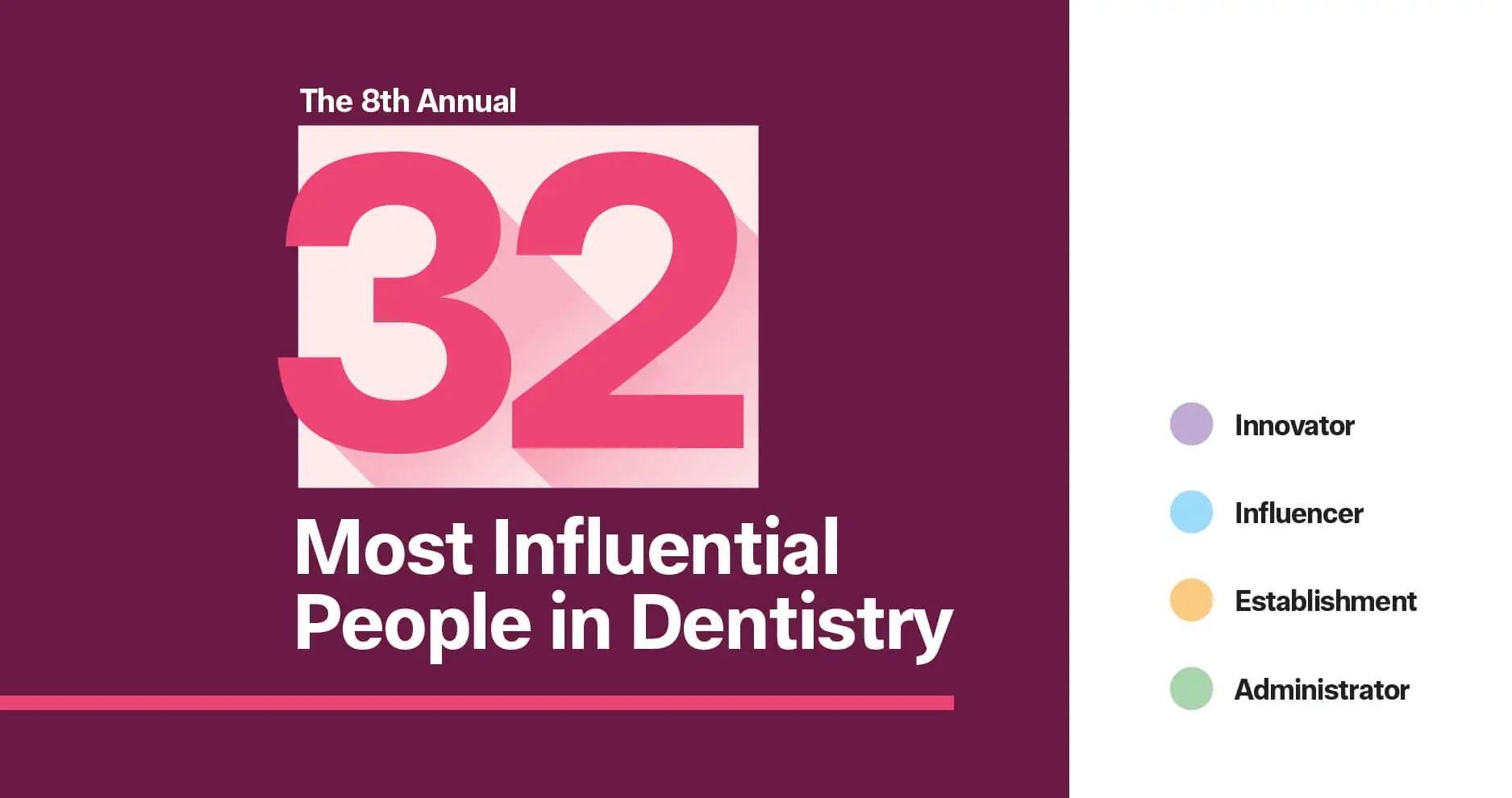
By Robert Elsenpeter, Edward Kobesky, and Alanah Simenkiewicz
Now in its eighth iteration, our annual 32 Most Influential People in Dentistry list has covered a wealth of topics and individuals over the years—the ongoing rise of the DSO, the ever-increasing numbers of women in the profession and of course a global pandemic that upended the industry for what felt like an eternity.
Throughout, we’ve sought to gaze at dentistry with as objective an eye as we can muster. We never tire of pointing out that “influence” is an inherently nebulous concept, its meaning thoroughly in the eye (not to say the eyeteeth) of the beholder. There’s monetary and budgetary administrative influence, of course, political heft, the power that comes with being a leading scientist or academic—and even the strange kind of sway held by those with the largest social media megaphones.
This year, as always, the choices were difficult. Surely we left off some deserving possibilities; maybe, to your lights, some who made the list lack the sort of heft that worthy candidates have. Have suggestions, comments, criticisms? Drop us a line at editor@incisaledgemagazine.com and let us know. In the meantime, consider the pages ahead a portrait of dental-industry influence, in all its guises, circa 2024.
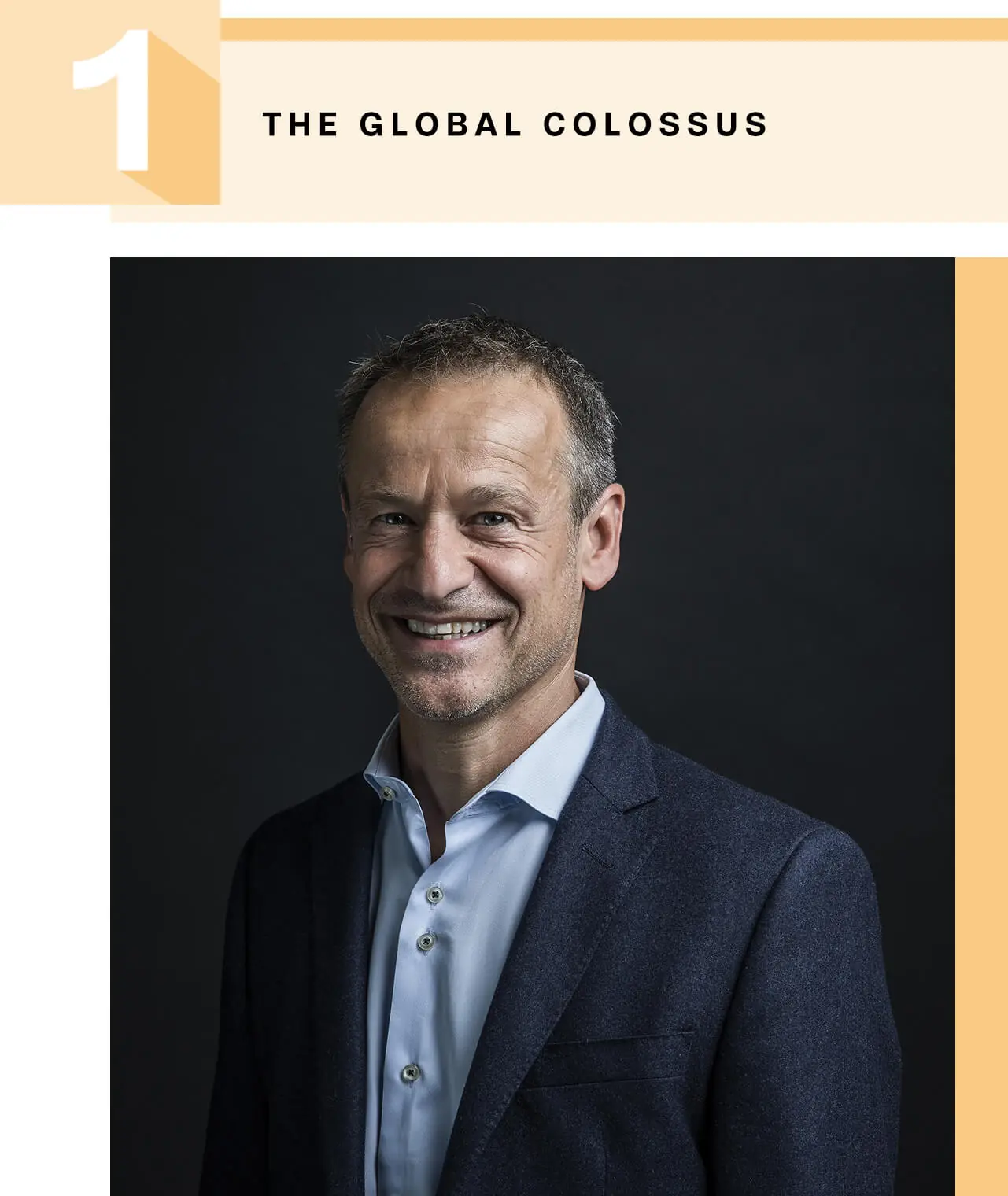
Guillaume Daniellot
CEO, Straumann
Basel, Switzerland
Last Year: 2
THIS POWERFUL executive has hovered around the apex of the 32 Most Influential list since he was named CEO of the Straumann Group in the fateful year 2020. Now he’s hit the top spot at last, and for good reason: Straumann, always a leader in dental implants, had a fantastic 2023. Third-quarter revenue jolted 11 percent, up some $627 million to a few bucks under $2 billion.
Such results don’t emerge from the ether. The company continues to bolster its offerings, having last September picked up AlliedStar, a Chinese manufacturer of intraoral scanners. The acquisition will enable Straumann to provide a competitive IOS solution to its customers in the Middle Kingdom, as well as cater to new price-sensitive markets and customer groups should Western sales begin to plateau. Under the Straumann Group umbrella, AlliedStar will maintain its current distribution channels, and the acquisition will take place in gradual installments over eight years, though Straumann’s assumption of a majority stake is imminent.
“We delivered strong results in a year that presented macroeconomic and geopolitical challenges,” Daniellot says. “Thanks to the dedication of our teams, we continued to grow while helping 5.6 million smiles globally, compared to 4.4 million in 2022.” Another acquisition—that of Swiss medical device maker GalvoSurge in May 2023—“enables doctors to achieve better clinical results and treat peri-implantitis,” he adds.
Straumann’s digital transformation continues apace as well; Daniellot cites the ongoing development of its AXS platform, which integrates the SmileCloud software application for smile design. AXS unites cloud-based clinical workflows for implantology and orthodontics, enhancing practices’ operational effectiveness. It incorporates software applications, services and solutions from Straumann for a soup-to-nuts remit: engaging with patients from the outset, treatment planning, performing initial diagnoses and monitoring patients post-treatment. AXS’s success last year has prompted Straumann to introduce it in the Asia-Pacific region later in 2024.
Artificial intelligence is naturally a primary Daniellot focus these days. In 2023, Straumann’s CoDiagnostix software enjoyed double-digit user growth, enabling the creation of precise surgical guides essential for implant surgeries. Introduced only in the fourth quarter of last year, the CoDiagnostix AI assistant facilitates digital implant position planning, offering a variety of measurement functions including automatic detection of nerve canals.
Straumann—which is headquartered in bucolic Basel, Switzerland, hard against the French and German borders— has around 4,000 employees in more than 90 locations across the globe. Its network of distribution subsidiaries and partners offers products and services under brands including Neodent, Medentika and others in addition to the principal company.
Daniellot was named CEO after spending 16 years with Straumann. “The focus is the customer,” he says simply. “This is the number one thing I ask of the company. The success of the customer is the success of the organization. Being able to spend time with customers and understand their needs to drive success in the practice is our core focus. The rest is just putting things in place.” Guillaume Daniellot has, at last, assumed his place atop this list of global dental-industry influentials.
“We delivered strong results in a year that presented macroeconomic and geopolitical challenges.” — Guillaume Daniellot
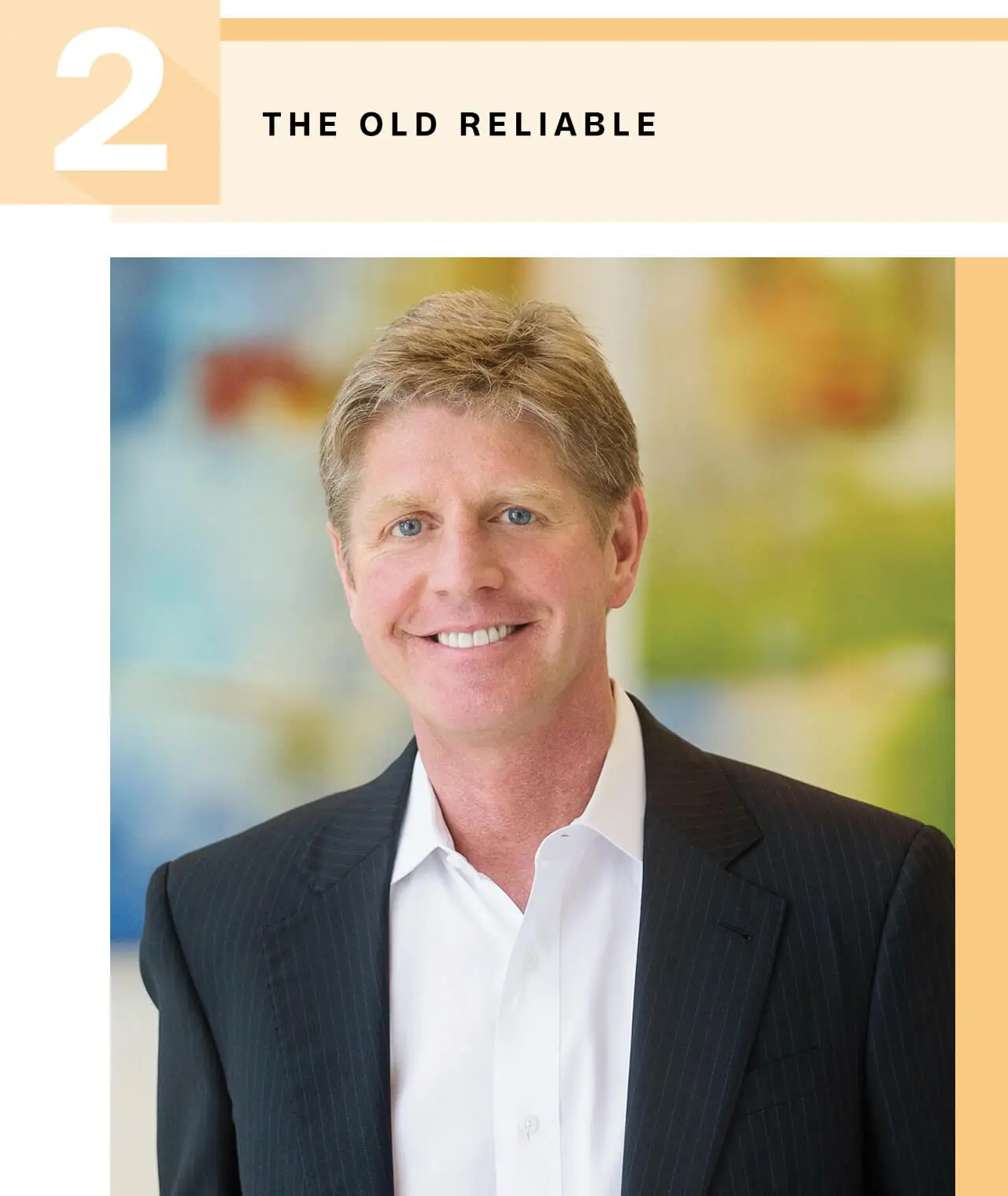
Joseph Hogan
CEO, Align Technology
San Jose, California
Last Year: 4
HELLO AGAIN, good sir. Hogan has populated so many positions among the top five on this list over the years that we ought to give him a commemorative medal. The reason is simple: Align Technology is a beast, in the very good sense of the word, strutting its stuff with (as of this writing) a $21 billion market capitalization.
Business isn’t always zero-sum, but some of Align’s recent wins seemingly had a lot to do with others’ losses. One main other, to wit: Smile Direct Club, the former industry darling now circling the drain in the wake of financial and other troubles. The result is that Align’s wildly popular Invisalign is the clear top dog in the extraordinarily significant clear-aligner space that also includes the struggling Byte, from Dentsply Sirona, and even ClearCorrect, a rare semi-misfire (so far) from Straumann (see Guillaume Daniellot, No. 1). Envista’s Spark, by contrast, is doing fairly well; it’s the exception in this critical market.
Hogan’s heroes have also spent an undue amount of time in court lately. This February, Align successfully fought off two antitrust class-action lawsuits filed by a pair of dental practices in 2020 and 2021, alleging that Align had engaged in anticompetitive conduct, raising prices on unwitting consumers. “We’re pleased that [the U.S. District Court for California’s Northern District] has ruled in favor of Align,” Hogan said after the court granted summary judgment dismissing the suits. “We invest more than $300 million annually in research and development to deliver world-class products that doctors and their patients trust, and we’re proud of our efforts to move an analog industry to a state-of-the-art digital one.”
One indicator that Hogan might further his residence near the top of this list for years to come: Not all of Align’s eggs are in the Invisalign basket. The company is well-positioned to help spur the coming AI revolution via Exocad and the iTero scanner, both CAD/CAM staples, and its R&D investments have remained steady. Practitioners, as the dismissed lawsuits indicate, have sometimes had beef with Align, but the relationship seems to be improving. It should continue to do so as the company diversifies its product mix. We surely have not seen the last of Joseph Hogan at these heights.
“We invest more than $300 million annually in research and development to deliver products that doctors and their patients trust, and we’re proud of our efforts to move an analog industry to a state-of-the-art digital one.” —Joseph Hogan

Rena D’Souza
Director, National Institute of Dental And Craniofacial Research
Washington, DC
Last Year: 16
DR. D’SOUZA HAS BEEN a fixture on this list in recent years, having graced the cover of the 32 Most Influential issue in 2021. The main reason for her prominence: the sheer number of dollars she controls as the head of the NIDCR, around 520 million of them in fiscal year 2024, a nudge higher than the figure from the previous year.
Her budgetary heft is to some degree affected by who controls Congress and who sits in the White House—President Biden’s budget for the 2025 fiscal year, which begins on October 1 of this year, boosts that figure to $521.7 million—but medical research of the sort the NIDCR does is about as bipartisan as issues get. Its funding sustains work spanning basic, translational and clinical studies on oral cancer, orofacial pain, tooth decay, periodontal disease, salivary gland problems, craniofacial anomalies and oral manifestations of systemic illnesses.
That’s a lot. So she does a lot. One of Dr. D’Souza’s most important tasks was overseeing the completion of the Surgeon General’s Oral Health in America report, released in December 2021. (We lauded its principal authors, Bruce Dye and Judith Albino, on the 32 Most Influential list in 2022.) It organized the contributions of more than 400 experts to plot a road map for the immediate future of dentistry and oral health more broadly.
The day-to-day allocation of grants and other funds is what truly gives D’Souza her outsize importance, though. The NIDCR alone provides 63 percent of the annual funding to dental schools by the National Institutes of Health, its parent organization, and its research, it says, “informs the practices of more than 200,000 dental health care providers in the United States.”
The NIDCR this year completes its lengthy commemoration of 75 years since its 1948 founding in the wake of World War II, which revealed severe oral health problems among America’s fighting men. That problem has certainly been vanquished in the decades since—and many more are likely to be with Dr. D’Souza (who declined an interview request, as is her tendency) in charge of so much research funding. Money talks, after all—and in many cases it cures as well.
The NIDCR alone provides 63 percent of the annual funding to dental schools by the National Institutes of Health, its parent organization, and its research, it says, “informs the practices of more than 200,000 dental health care providers in the United States.”
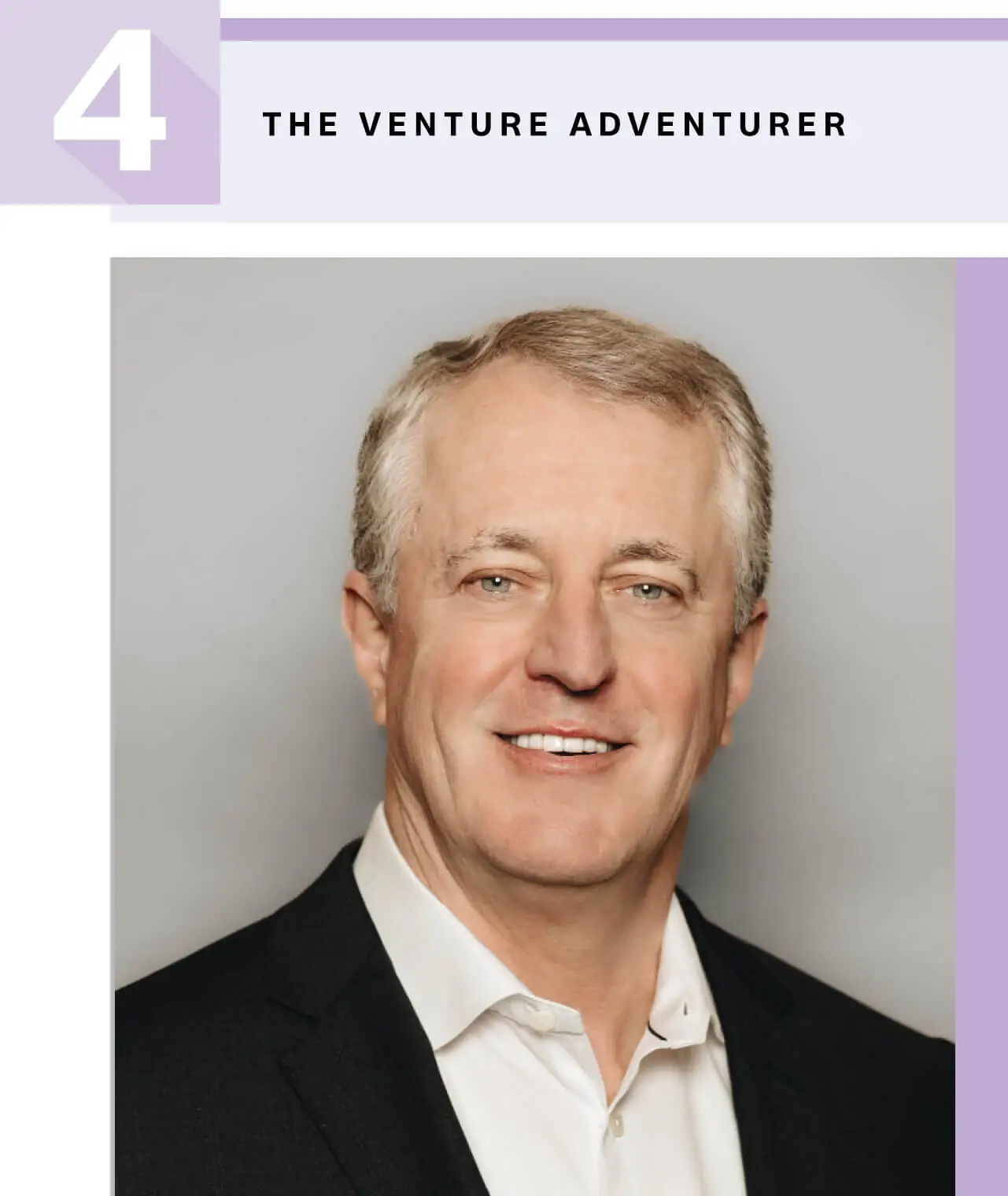
Doug Brown
Managing Partner, Dental Innovation Alliance
Raleigh, North Carolina
New
INNOVATION IN DENTISTRY is necessarily fueled by capital investment—some of it public (see Rena D’Souza, No. 3) and some private. In the latter category, perhaps no one currently plays a more important role than list newcomer Brown, whose venture firm, Dental Innovation Alliance, invests in early-stage dental health technology companies.
It does so, he says, by “curating and connecting investors and entrepreneurs, and providing high levels of post-investment support.” Over the past 15 years, Brown has invested in and advised a dozen early-stage companies, as well as four DSOs, the growth of which he had previously overseen as the head of Affordable Care and Dental Partners, two national DSOs. In the late 1990s, he formed and led a study group of 10 digital industry leaders, which eventually became the Association of Dental Support Organizations.
“Dentistry has largely been a cottage industry for decades, with the solo practice model being the predominant one,” Brown tells Incisal Edge. “This has limited innovation, since dentists focusing solely on patient care have found it challenging to both afford and find time to test new technologies and techniques.” He has identified three significant trend shifts in the last two decades, however:
1) Large DSOs have created teams devoted to testing and improving practice operating models; 2) the advent of artificial intelligence, 3D printing and advanced imaging, regardless of their initial purpose, has shown great promise for dentistry; and 3) graduating dental students who have grown up utterly accustomed to rapid technological change naturally embrace—or even demand—the most current equipment at the outset of their careers.
As such, he says, “we’re now at the intersection of a high demand for innovation through creative technologies and a plentiful supply of solutions that are being created by ambitious entrepreneurs. DIA’s job is to efficiently connect this demand and supply.”
DIA is actively tracking more than 800 early-stage dental-tech companies and receives some 30 new inquiries every month. “The surge in ideas and new companies is so recent,” Brown says. “DIA is very selective in choosing the companies that it supports, investing in less than 1 percent of all companies that come our way. That said, a much higher rate will succeed since most of the concepts we see are compelling.”
“We’re now at the intersection of a high demand for innovation through creative technologies and a plentiful supply of solutions being created by ambitious entrepreneurs.” —Doug Brown
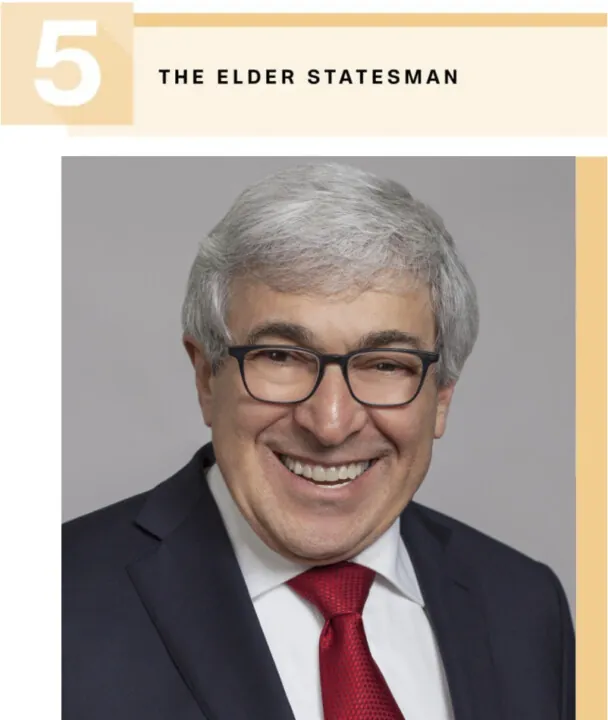
Stanley Bergman
CEO, Henry Schein
Melville, New York
Last Year: 4
THINK OF HIM as dentistry’s immobile object—the staunch lifer who has wielded so much influence for so long that he essentially embodies the company he leads. Think of, in decades past, GE’s Jack Welch, or more recently Meta’s Mark Zuckerberg. Having been CEO of Henry Schein since 1989, Bergman, a constant presence near the top of this list, is one of the longest-serving chief executives of a Fortune 500 company.
Over the last 35 years, the South Africa–born Bergman has guided Henry Schein from a small mail-order supply shop to a $12 billion (annual revenue) health care supply juggernaut, offering products and services to more than 1 million dentists and other medical personnel around the world.
It’s true that 2023 was an occasional challenge. Schein’s website fell victim to a cyberattack last September, with hackers compromising the personal data of some 29,000 people. The hackers had been inside the network for more than two weeks before being discovered. Schein worked to contain the problem and offered discounts to customers who went elsewhere while its services were down, but on its third-quarter earnings call, the company stated that 2023 sales growth would be negatively affected by the breach. Its stock ebbed but quickly recovered, surely to some degree due to the brand equity and stability that Bergman himself represents. Succession, as always, is an open question, but for now he isn’t going anywhere.
“Get everybody engaged,” he says by way of leadership advice. “To me, the most successful leaders are the ones who could run a great summer camp. Can they get everyone to play the games? That’s critical. There’s no room in the world any longer for bosses. It’s about coaches, facilitators and mentors. You make a lot of mistakes, but then you celebrate the achievements.” The C-suite as summer camp? It’s just more unorthodox thinking from one of the best ever to do it.
“There’s no room in the world any longer for bosses. It’s about coaches, facilitators and mentors. You make a lot of mistakes, but then you celebrate the achievements.” —Stanley Bergman
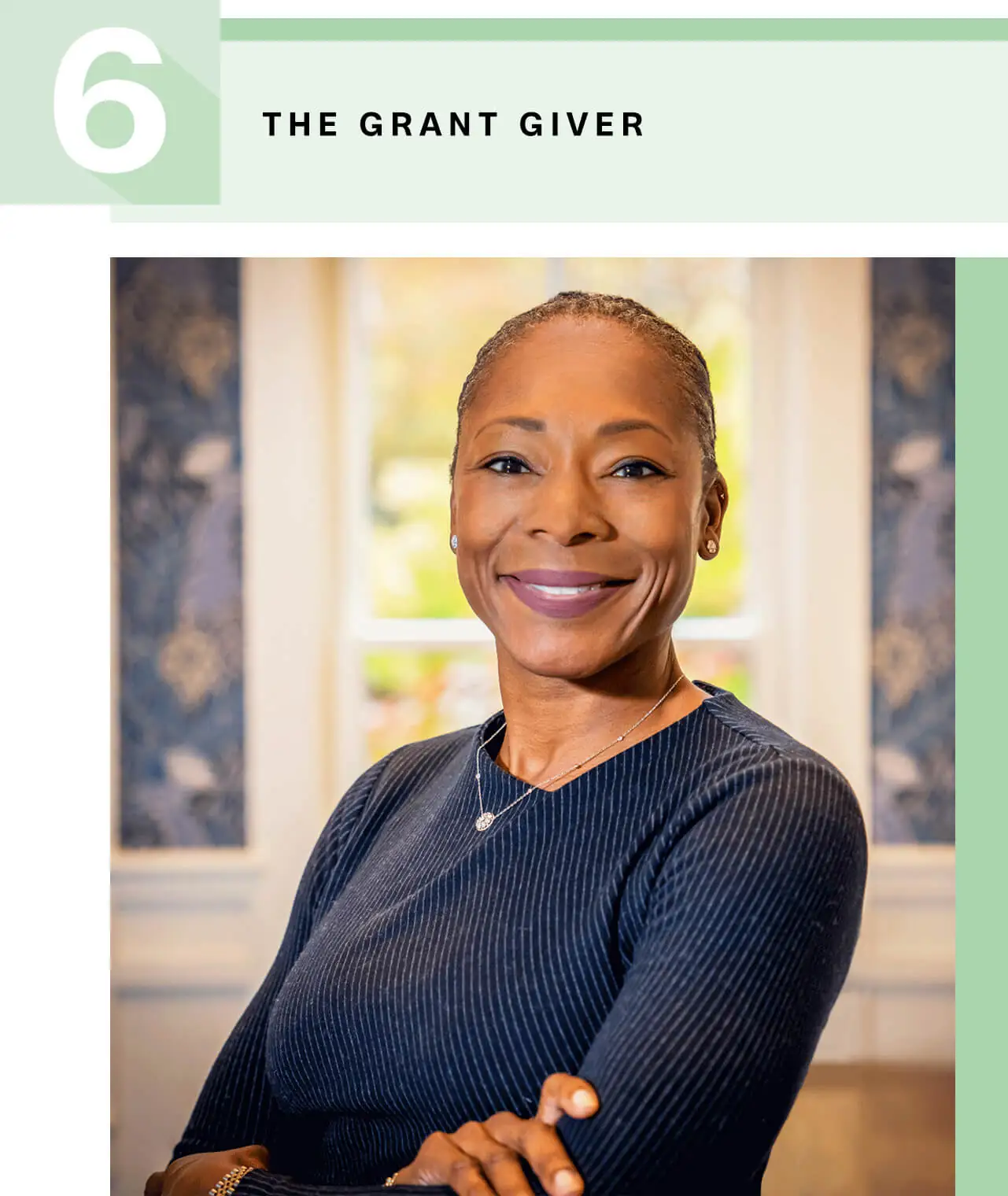
Myechia Minter-Jordan
CEO, CareQuest Institute for Oral Health
Boston
New
IT’S NO SECRET that underserved communities score poorly on just about every measure of oral health. In steps Dr. Myechia Minter-Jordan, the head of the CareQuest Institute for Oral Health, a Boston-based organization that aims to stem these inequities through a variety of grants and awards. CareQuest is relatively new; it became operational in 2015 and is financed primarily through an endowment spurred by the 2022 sale of its majority stake in the U.S.’s largest Medicaid dental benefits administrator. It encompasses a private foundation and a for-profit impact investing and innovation advancement company, as well as a more prosaic dental benefits firm serving employers and residents throughout Massachusetts.
“Oral health is inextricably linked to overall health,” Dr. Minter-Jordan tells Incisal Edge. “Evidence shows the strong relationship between mouth and body—from diabetes to dementia, poor oral health outcomes can increase the risk of developing or exacerbating systemic diseases.”
The daughter of a nurse, Dr. Minter-Jordan is a physician and former CEO of the Dimock Center, one of the largest Federally Qualified Health Centers in Massachusetts.
She’s willing to help, and open to assistance from, just about everyone. “I’ve sat across from government officials, nonprofits and private companies, urging them to partner with and invest in our health center and in our community,” she says. Keep your eyes peeled this August, when the CareQuest Institute’s Philanthropy Team will announce its latest grants—10 projects at $125,000 each through the Veteran Oral Health Request for Proposal, projects it says “will help increase the understanding of factors that influence oral health equity for veterans facing barriers to care.”
Though CareQuest declined to break down the details of its endowment, its most recent IRS Form 990 from 2022 shows it’s operating with a huge and growing pool of cash and investments, over $2 billion. While the organization is too new for anyone to establish what its average annual giving rate is (or might one day become), even a modest 5 percent per annum would translate to the neighborhood of a $100 million boost for U.S. oral health care in the coming years. That’s a big influx of much-needed investment.
“I’ve sat across from government officials, nonprofits and private companies, urging them to partner with and invest in our health center and in our community because I saw the complex needs of patients and families every day.” —Myechia Minter-Jordan
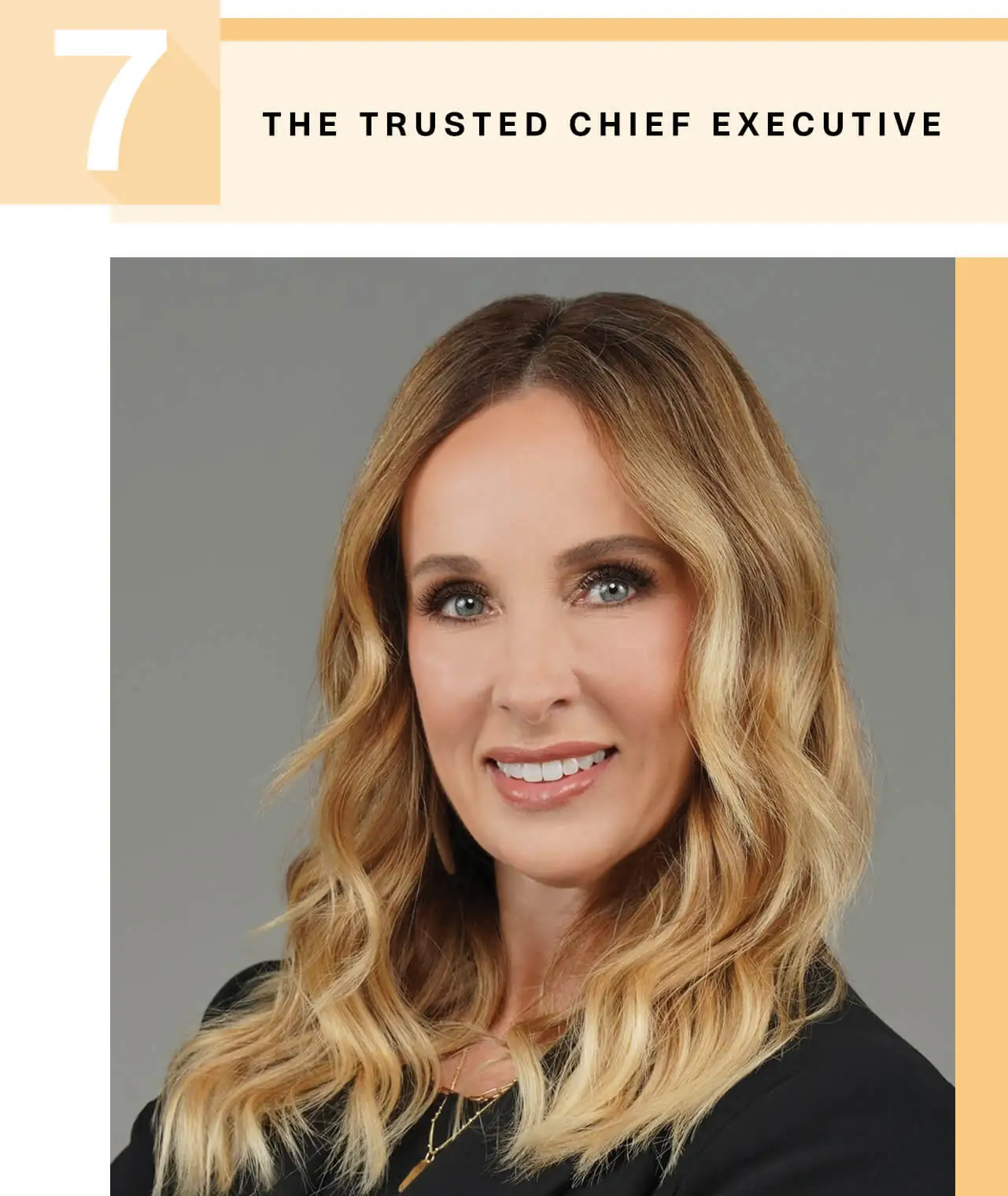
Stephenie Goddard
CEO, Glidewell Labs
Newport Beach, California
Last Year: 10
APPLE’S MEMORABLE coinage from 2009—“there’s an app for that”—has never been truer, as one look at the device in your pocket will presumably show you. And now Glidewell, under the steady leadership of Stephenie Goddard, is betting on the success of its app that makes its newest smart oral appliance go.
This May, Glidewell—helmed by Goddard since the first day of 2022, when she took over from the firm’s legendary namesake founder, Jim Glidewell—acquired ORB Innovations, a British startup that has developed a fitness tracker worn in the mouth. Technological innovation has long been Glidewell’s stock in trade, but this is its first investment in a smart device of this kind. “We see the platform that the ORB team has developed as an exciting evolution for the sports market,” Goddard says. “And it’s easy to envision its application in other wellness-related areas, in line with Glidewell’s mission to bring innovative solutions to dental practitioners and their patients all over the world.”
The company isn’t straying too far from its core offerings. It has so far fended off a challenge from Manhattan-based digital lab Dandy Dental, despite the latter’s having raised $172.4 million over multiple funding rounds.
The lesson is clear: Digital upstarts understandably feel like they have the wind at their back, but even a company that has been around five decades can thrive if it’s nimble enough. Under Goddard’s steady hand, Glidewell is.
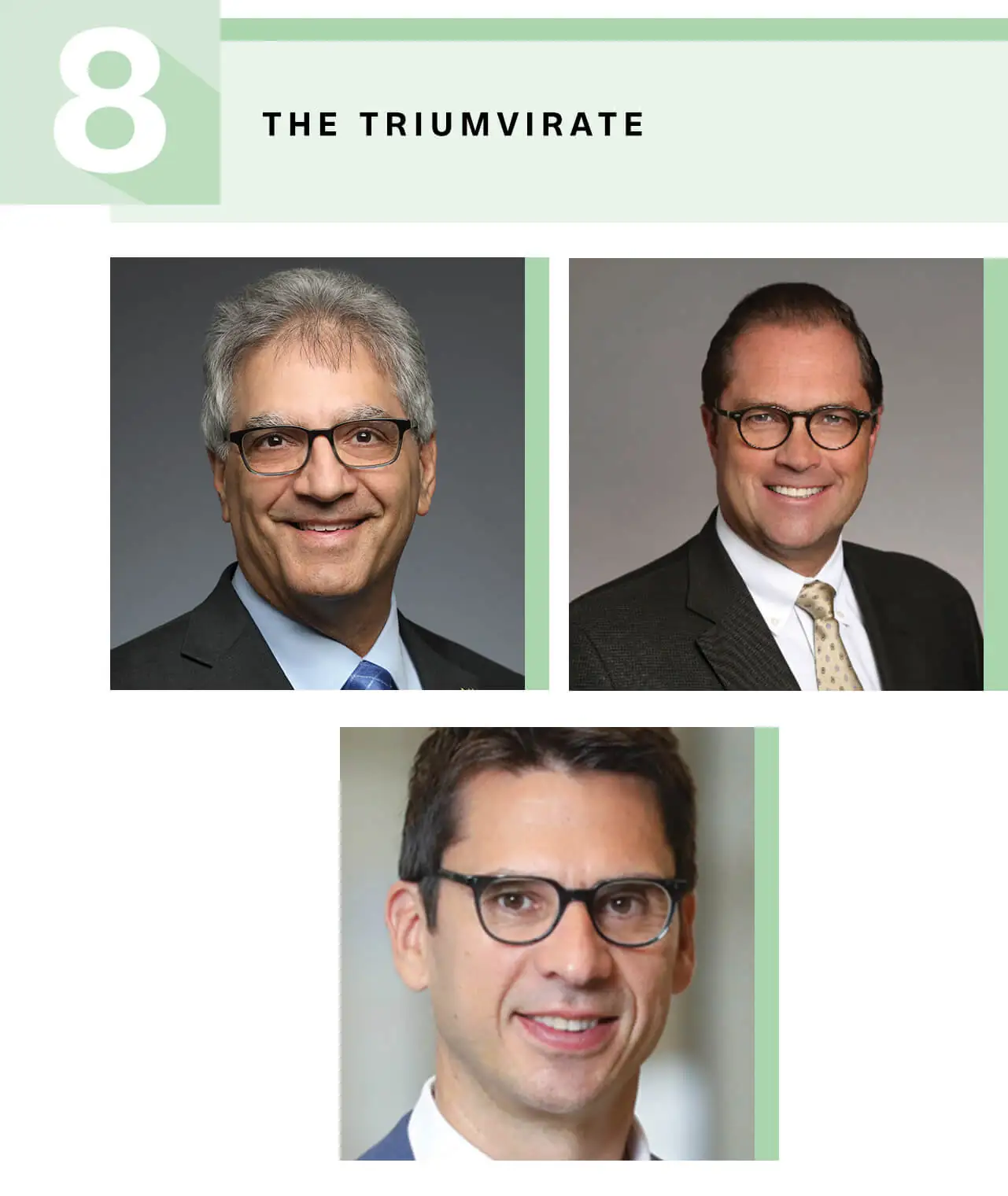
Raymond A. Cohlmia, Michael Graham and Marko Vujicic
Executive Director; Chief Lobbyist; and Chief Economist, American Dental Association
Chicago; Washington, D.C.; Chicago
Last Year: 7 (all)
THIS TRIO, whose tasks harmonize into a beautiful whole for the benefit of ADA members, make up an effective, forward-thinking leadership team for the giant advocacy organization. Big things have recently been afoot, most significantly the ADA’s October merger with the Forsyth Institute, the Boston-based research outfit, to create the ADA Forsyth Institute (see “Blended Family,” Incisal Edge, Spring 2024). “[The tie-up] will immediately change the landscape for oral health research and innovation,” Dr. Cohlmia says. “Oral health is integral to overall health, and this combination of mind share will bring technology and health care advances to patients at a global scale. Together, we will improve lives through transformative research that starts in the lab and ends with improving patient care in the dental chair.”
At Dr. Cohlmia’s side, figuratively and sometimes literally, are Graham and Vujicic, heading industry advocacy and economic analysis, respectively. Two bills in particular that Graham, his work informed by Vujicic’s analysis, has dealt with on Capitol Hill bear watching:
- The Action for Dental Health Act, which passed in March, reauthorizing grants for states to support dental health workforce activities in areas with a shortage of health care providers.
- The Restoring America’s Health Care Workforce and Readiness Act, which is stuck in committee but would double funding for the National Health Service Corps’ scholarships and loan repayment programs for health care workers, including dentists and dental hygienists, who serve in federally designated shortage areas.
Maintaining forward momentum is front and center for Dr. Cohlmia, the former dean at the University of Oklahoma College of Dentistry who has headed the ADA since November 2021. “We have a significant opportunity to improve our culture and processes,” he says—with which the Forsyth merger certainly should help. “The excitement is living in the future.”

Bill Dorfman
Dentist, Multimedia Influencer
Los Angeles
Last Year: 12
WHO, PRAY TELL, are some of your famous clients, Dr. Dorfman? “How many do you want?” replies the irrepressible (dare we say fittingly immodest, given his milieu) owner of Century City Aesthetic Dentistry. “I treat everybody in Hollywood.”
He’s not kidding. His clientele include Mark Wahlberg, Kathy Bates, Usher, Paula Abdul, Jason Alexander, Eva Longoria and Hannibal Lecter himself, Sir Anthony Hopkins. (Keep your guard up around that one, doc.) He’s also the man behind singer Katy Perry’s Guinness World Record–breaking “Million Dollar Grill,” the gleaming rictus she showed off in her 2017 video for the song “Dark Horse.”
Dr. Dorfman isn’t just a name dropper—he’s also a product dropper, having released his new tooth whitening tool, POOOF!, in 2023. “It’s a revolutionary whitening strip that actually melts on your teeth,” he says. “With other whitening strips, at the end of the process, you need to remove the strip and dispose of it. POOOF! strips actually dissolve. Vanish. Melt away.” A 10-day in vitro study his research team conducted determined it was 37 percent more effective than the leading whitening strip, he says. “We did a very soft launch in 2023, but we’re going to hit the market very aggressively in [summer] 2024.”
He spreads his gospel through his highly active social media presence, most notably his Instagram account, @drbilldorfman, which has 2.2 million followers. “Instagram has been very, very successful for me,” Dr. Dorfman says. “I typically try to post at least once a day—a combination of dental cases, health and fitness content, and content from my nonprofit, the LEAP Foundation [leapfoundation.com], which is a motivational leadership program for young entrepreneurs. Typically, my posts are centered on one of these three topics.” We say: Come for the dental information, stay for the beefcake photos of Dr. Dorfman himself. Hey, we did say he’s immodest.
“I treat everybody in Hollywood.” —Bill Dorfman
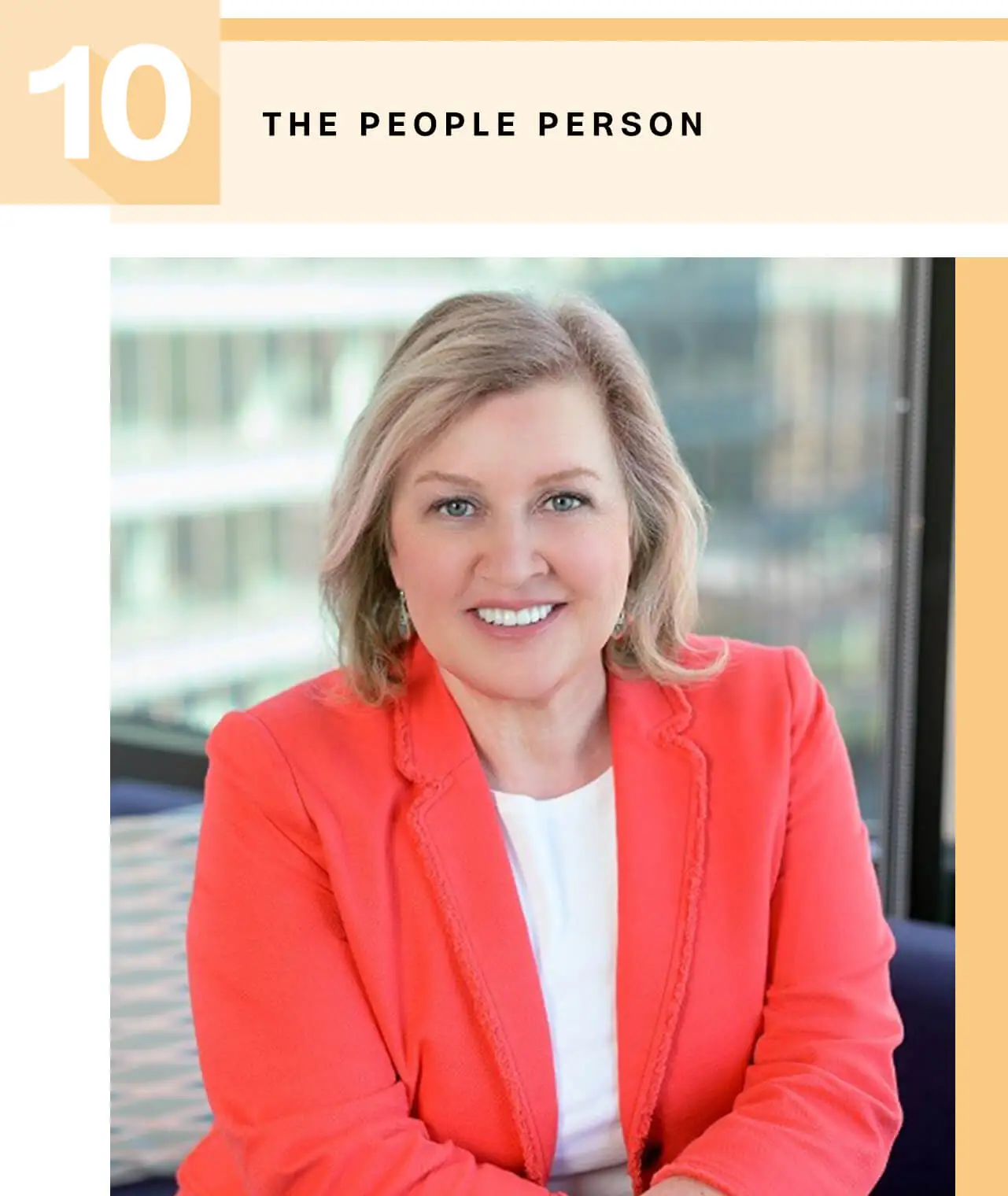
Sarah Chavarria
CEO, Delta Dental of California
San Francisco
New
HAVING TAKEN THE reins of Delta Dental of California on January 1 after the retirement of former CEO Mike Castro (No. 14 on our 2023 list), Chavarria is now in charge of a dental benefits company that encompasses 15 states and the nation’s capital.
She has been with Delta since 2017; previously she was chief people officer at NantHealth, a technology company headquartered in North Carolina. She served in a similar capacity at Optum360, a joint venture between Optum and Dignity Health. “What I love about health care is that we all know the patient experience that we want for ourselves and for our loved ones,” Chavarria says. “Working in the health care industry, helping to shape that experience and bringing about change, is something I’m very passionate about.”
Delta Dental of California covers more than 25 million people and is accepted by some 156,000 participating dentists. It employs more than 4,100 people, which offers Chavarria another route to engage people. “At my core, I’m just trying to be a good coach,” she says. “I like to help paint the picture about where we’re going or what we’re trying to accomplish, to get people excited about something that’s coming. We want to make sure we’re delivering access to quality care, period.
We do that through focusing on patient experience and partnering better with providers to deliver that patient experience. The ripple that runs through all of that is quality.” She has a big job ahead of her at this big industry player. We, and plenty of others, will be watching.

Brian Babin (R-TX); Drew Ferguson (R-GA); Jeff Van Drew (R-NJ); Mike Simpson (R-ID); Paul Gosar (R-AZ)
U.S. Representatives
Washington, D.C.
Returnees
THOUGH THEY ALL sport the GOP’s “R” after their names, these five run the gamut in terms of their politics and their personal style, from Jeff Van Drew (a moderate former Democrat) to Paul Gosar, a MAGA man in full who was censured and removed from two committee slots in 2021 for social media posts that depicted him murdering a colleague and attacking President Biden.
The dental- and other medical-specific issues they tackle vary as well. Dr. Babin is a sponsor of the Resident Education Deferred Interest Act, which aims to rein in exorbitant interest payments on school debt. “As a dentist, I know firsthand how expensive graduate school is,” Dr. Babin has said. “By the time many medical and dental school students finish their training, ballooning interest payments too often prevent them from further specializing in practices or serving rural areas far from large hospitals.”
In 2023, Dr. Simpson cowrote the reauthorization of the Action for Dental Health Act, which provides support to organizations that deliver oral health care to underserved populations, especially seniors and children in rural areas, through fiscal year 2028. “As a former dentist, I know that the more we can provide patients with an early diagnosis, the better off our patients and our health care system will be,” he says.
As House members, all five are up for reelection come November. It wouldn’t be a surprise to see them all back here on next year’s list, though—despite his antics, for example, Dr. Gosar took 66 percent of the vote in his 2022 GOP primary and then, running unopposed in the general election, romped home with a downright Soviet-like 98 percent of the vote. Change comes slowly to Washington, D.C.
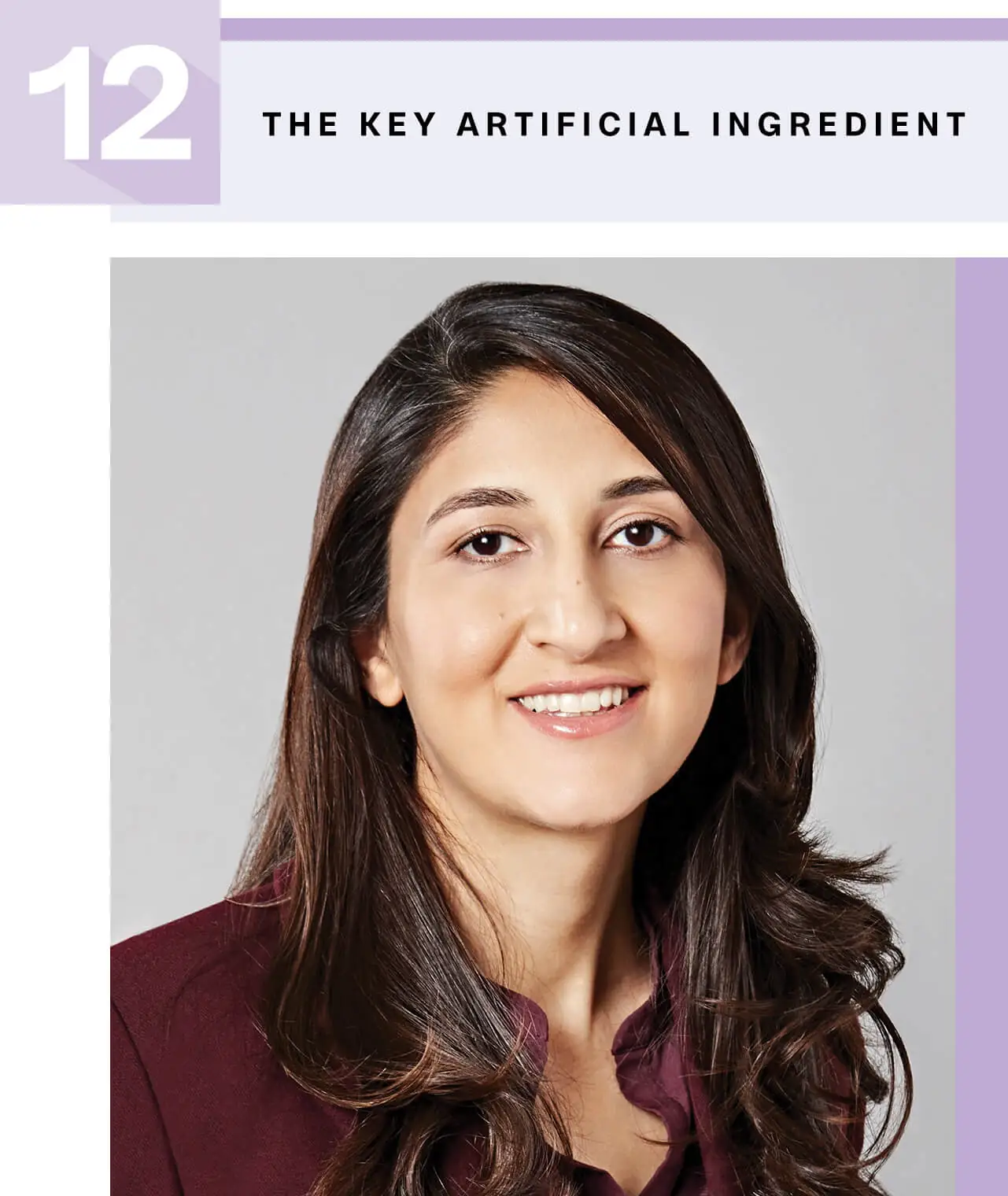
Wardah Inam
Founder and CEO, Overjet
Cambridge, Massachusetts
Last Year: 5
SHE WAS INTO artificial intelligence before AI was cool, man—and before it had achieved full escape velocity and become ubiquitous throughout American industry and even popular culture. The cover star of our Spring 2022 Year in Innovation issue, Inam and her company, Overjet, are an immense player in dental AI. Overjet has the most FDA clearances (five) of any dental AI business and is (for now, but it has had an enormous head start) the default AI program for dental insurance companies looking to streamline their operations. Earlier this year, the company raised $53.2 million at a $550 million valuation in a Series C funding round, the largest investment ever in artificial intelligence for dentistry. That capital infusion increased Overjet’s total funding to around $133 million.
It’s broadening its remit, too: In 2023, it debuted Overjet for Kids, which the company says “helps pediatric dentists build a lifetime of trust with patients—by catching subtle tooth decay in X-rays before children feel pain, and by better explaining their recommendations to parents.”
“I founded Overjet to elevate the standard of care in dentistry and enhance patient outcomes through AI,” Inam said after the most recent financing round. “This funding will help us further accelerate our mission to improve patient outcomes, by making dental AI ubiquitous. The next step is to seamlessly connect the process of diagnosing and treating pathologies with the process of reviewing and approving claims. Soon, doctors and patients will be able to get benefits decisions in real time—while insurers will be able to dramatically improve their member experience.” In AI, the early bird gets the most lucrative worm—and no one woke up earlier than Overjet.

Pat Bauer, Robert Fontana and Steve Thorne
CEO, Heartland Dental; CEO, The Aspen Group; Founder and CEO, Pacific Dental
Effingham, Illinois; Chicago; Irvine, California
Last Year: 17 (all)
THESE THREE AGAIN? Yep, these three again. The three kings of dental service organizations are back in their typical Goldilocks spot on this list: neither too high nor too low, just chugging along exerting their customary influence. Bauer’s Heartland Dental, founded in 1997, is far and away the largest DSO, serving more than 1,700 practices across 38 states, with a record 100-plus new supported practices in 2023. Pacific Dental supports more than 4,000 dentists in nearly 1,000 offices across 24 states.
A key figure to watch in the year ahead will be Fontana, who has piloted Aspen since he founded it in 1998. Why? In late 2021, the former Aspen Dental rebranded itself, tellingly, the Aspen Group, and has since added verticals including veterinary, human urgent care and aesthetics—none typically the bailiwick of the standard DSO model.
The Aspen Group includes Aspen Dental Management, Inc., which has nearly 1,100 locations, and ClearChoice Management Services, with 102 locations. “It’s hard to understand everything it took to get us here,” Fontana says. “But it was the original idea that we could do something different for a big part of the population where we thought their needs were not being served by practice models at that time.”
Interestingly, after all these decades in business, none of the big three DSOs is publicly traded, and if any of the three kings is mulling a public listing, he’s keeping it quiet. That gives them far more control over the business strategy, but at the possible expense of a fresh infusion of capital. Who will be the first to test the public-market waters? We’ll all have to wait and see.
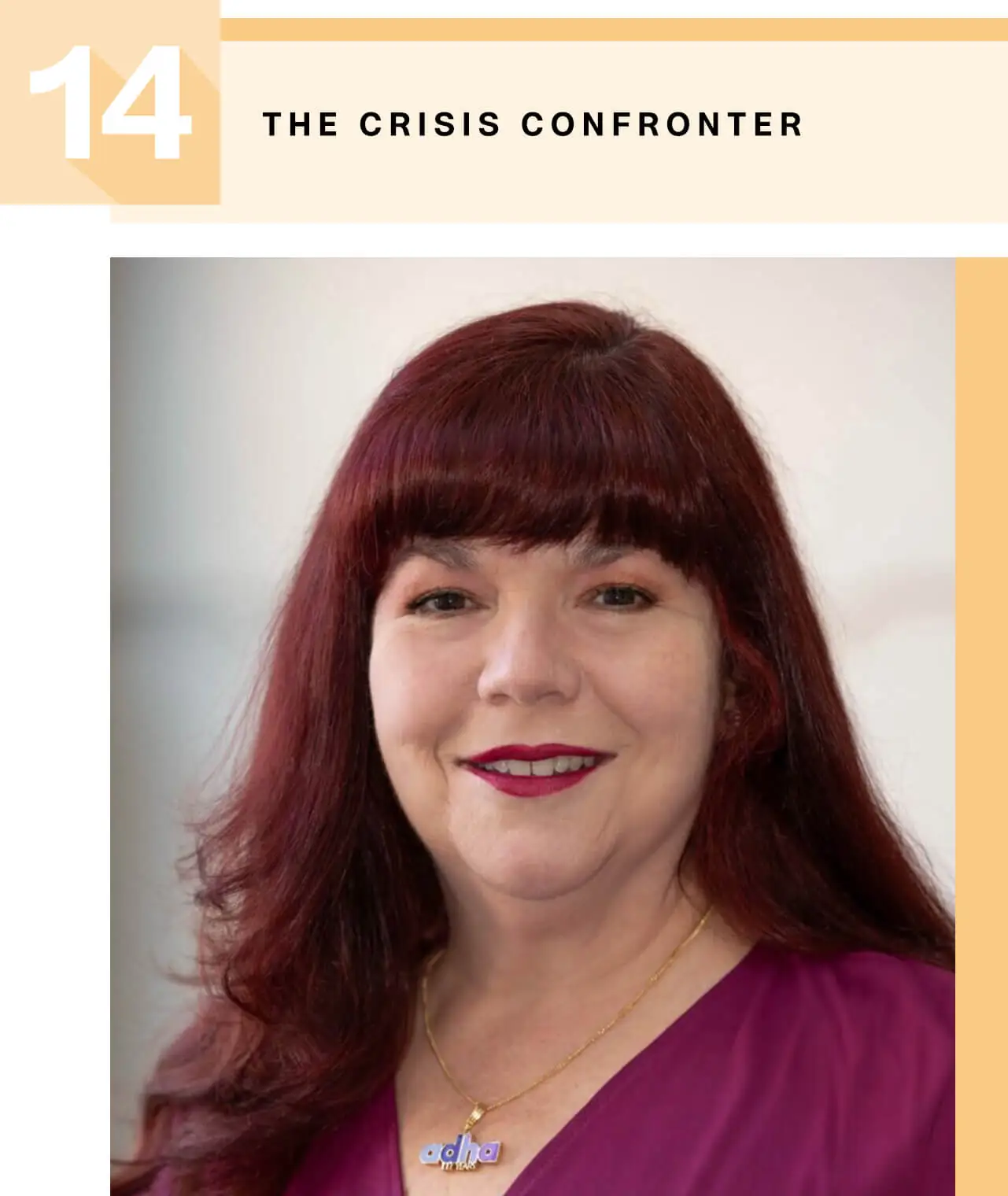
Becky Smith
President, American Dental Hygienists’ Association
Chicago
New
ANYTIME THERE’S a crunch related to dental hygiene, leaders at the ADHA inevitably find themselves on the hot seat. Smith’s term as president may already be complete if you’re late catching up on your reading, but the eminently capable scholar and educator has successfully presided over the organization during eventful times. Following the untimely passing last year of the ADHA’s former CEO Ann Battrell (see “Where Did They Go?”), current board-appointed interim CEO and 13-year ADHA veteran Jennifer Hill has stepped into the role.
Both have been confronted with a dental workforce shortage not of their making, and for which there are no easy solutions (see “The Great Hygienist Shortage”). However, the ADHA has responded ably, just as it did during the pandemic with guidance for returning safely to work.
The organization scored a major win during Smith’s term, in concert with the ADA, Department of Defense, the Council of State Governments and other leading oral health care organizations, by prominently advocating for the Dentist and Dental Hygienist Compact. It addresses license portability and cuts red tape for dentists and dental hygienists who relocate across state lines. As of this writing, nine states have signed on, with more expected, making it “easier for hygienists to move throughout the country and take positions where they’re needed most, and that means increased access to care for patients,” Smith says. More good news: Though the numbers have fluctuated, applications and students accepted to hygiene programs are higher than they have been since 2012, according to the 2022-23 Survey of Allied Dental Education by the ADA’s Health Policy Institute.
Over the longer term, the ADHA points to concrete solutions for recruiting and retaining a robust workforce, borne out by a 2022 report from the ADA, ADHA and other groups: health insurance and paid leave for all, annual raises plus more responsive compensation in general and a greater focus on workplace culture. “ADHA advocates for workplace improvements and addresses these issues through resources and continuing education across multiple platforms,” Hill says. When pressed for progress on any search for a permanent CEO, an ADHA spokesperson said the board would not comment. Meanwhile, Smith will be succeeded this summer by incoming president Erin Haley-Hitz. Stay tuned. —Edward Kobesky
Nine states have signed on to the Dentist and Dental Hygienist Compact thus far, making it “easier for hygienists to move throughout the country and take positions where they’re needed most,” Smith says, “and that means increased access to care for patients.”
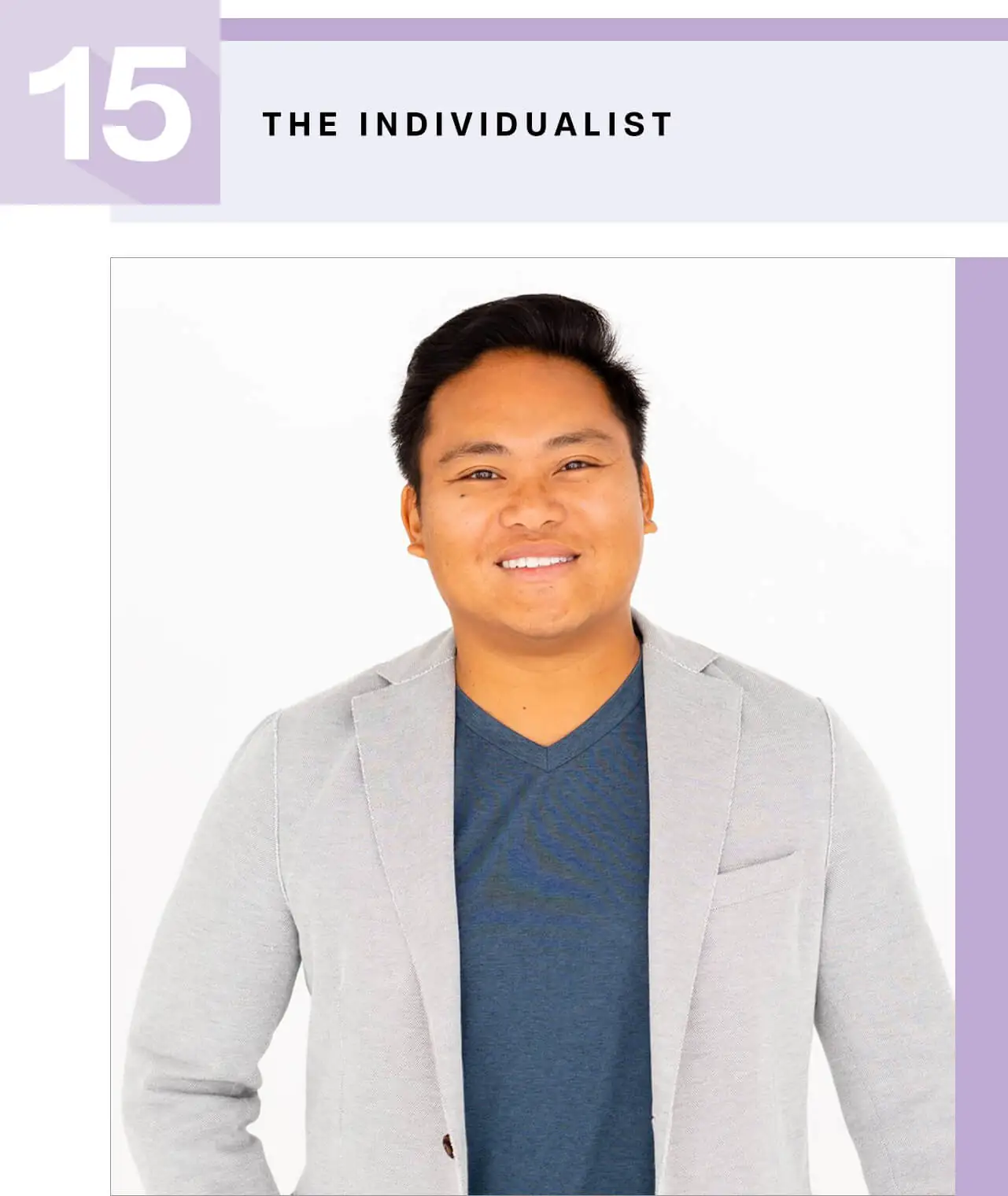
Chris Steven Villanueva
CEO, MB2 Dental
Dallas
Returnee
IT MIGHT SEEM like mere semantics, but nuance matters: MB2 Dental, led by Dr. Villanueva, is a dental partnership organization (DPO), not a DSO like the firms run by the guys over there to the left at No. 13. About a decade and a half ago, Dr. Villanueva found himself in search of a new cooperative model. DSOs, he thought, stripped practices of their individuality as the cost of their services. So he founded MB2.
“Building a practice on your own is no easy task,” he says. “I rejected the idea that our only options were to keep practicing alone or sell out to a faceless corporation. So I partnered with others to build a better way to practice dentistry.”
MB2’s model is simple enough: Give dentists sufficient autonomy to do what they want and practice how they want to practice. It’s catching on: Since its founding in 2007, it has partnered with more than 685 practices across 39 states, making it already one of the 10 largest DPOs—DSOs, whatever—in the country.
Plans for further expansion are afoot: This February, MB2 closed a $2.3 billion debt facility with renowned private equity firm KKR, which it intends to use to finance upcoming acquisitions. “MB2 Dental’s access to this new credit facility demonstrates a true endorsement of our strong historical performance and confidence in our growth pipeline,” Dr. Villanueva says. “We’re seeing unprecedented interest in our partnership model that allows doctors to combine the benefits of joining a larger community with the independence that they love about private practice. The new financing will further accelerate our ability to disrupt the dental profession and continue our nationwide expansion as the fastest-growing dental group in the country.”
Dentists, like anyone else, just want to be themselves—and if they can do exactly that while taking advantage of practice-enhancing things like shared services and access to capital, well, so much the better.
“I rejected the idea that our only options were to keep practicing alone or sell out to a faceless corporation. So I partnered with others to build a better way to practice dentistry.” —Chris Steven Villanueva
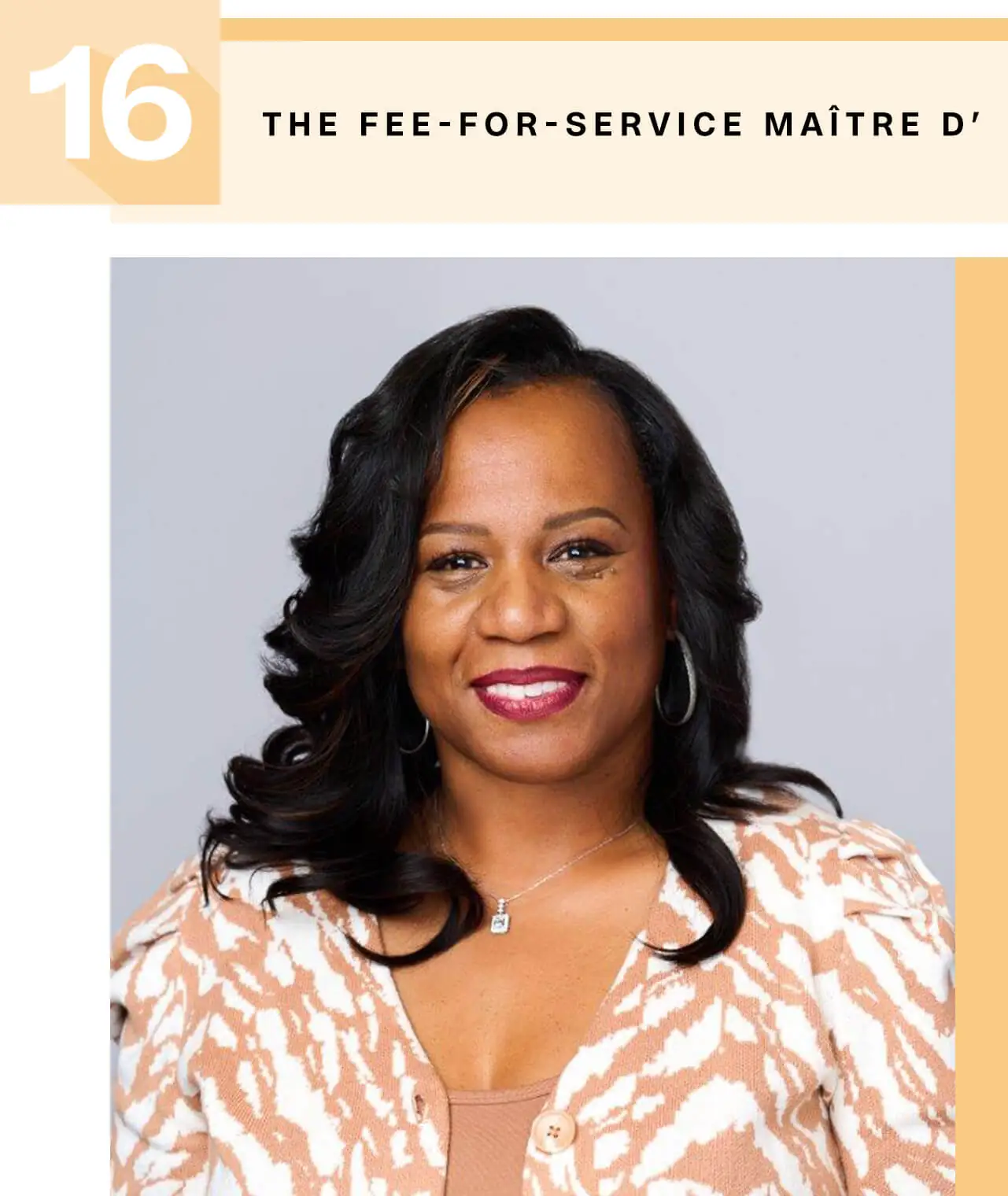
Sonia Williams
Senior Vice President and General Manager for Dental, CareCredit
Xenia, Ohio
New
WILLIAMS TAKES OVER from Bete Johnson, a recent regular on this list (No. 25 in 2023) who this March was nudged up the C-suite into the role of executive advisor to CareCredit’s CEO, Beto Casellas. It’s a big task: CareCredit is by far the No. 1 facilitator of fee-for-service dentistry, an important role given dentistry’s murky relationship with traditional medical insurance.
The need is acute. “Our Dental Lifetime of Care study from 2023 revealed a shocking 92 percent of people would hold off on general dental care because of the cost,” Williams tells Incisal Edge.
That’s the potential CareCredit difference for patients. What about practitioners? “Making finance part of patient conversations is important to ensure patients are aware of all options,” she says. “Insurance coverage, assistance programs, Health Savings Accounts, Flexible Spending Accounts and financing options, in-house or third-party, can factor into whether a patient is able to proceed. For practitioners, delayed time to payment can [affect] business operations, making clear financial communication all the more important.” A boon on both sides of the coin plus high demand equals good business. “Our health and wellness division saw $13.3 billion in average loan receivables, including those held for sale,” Williams says.
Intriguingly, Williams came to the job with no prior experience in dentistry, having spent nearly three decades in manufacturing, retail and other financial services. “My background is largely in marketing and sales, so I see my role focused on a variety of facets within dental: subject matter experts, dental associations, DSOs and individual doctors alike,” she says, citing the imperative “to support their business growth and extend a helping hand for consumers to get the care they need.”
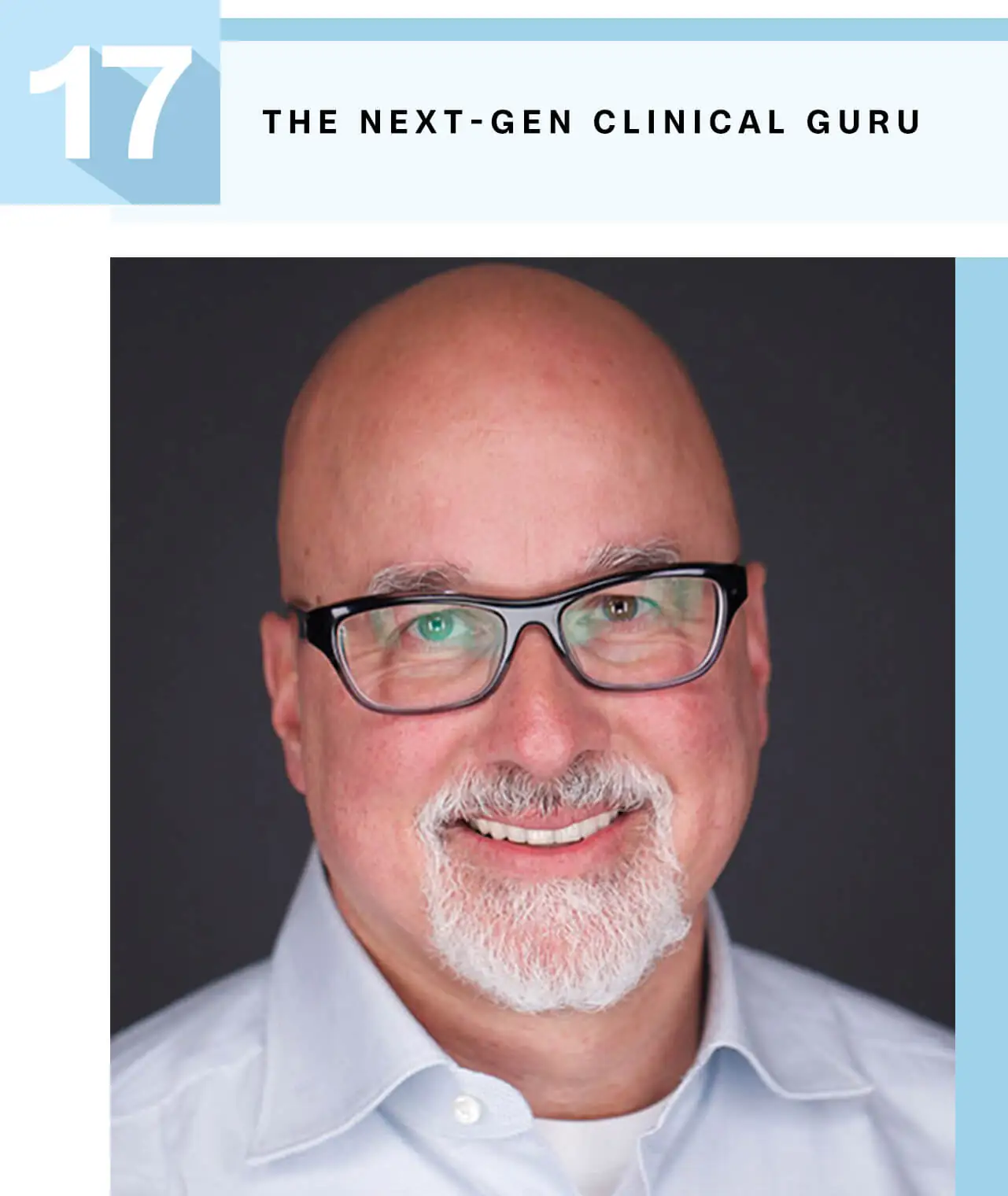
Bob Margeas
General and Cosmetic Dentist; Industry Thought Leader
Des Moines, Iowa
New
IF JAMES BROWN was the Hardest-Working Man in Show Business, Dr. Margeas is surely the hardest-working man in dentistry. He’s a successful private clinician; a room-packing speaker and road warrior; editor or editorial board member for three dental journals (Inside Dentistry, Compendium and Oral Health, a Canadian publication out of Toronto); and an adjunct professor at the University of Iowa College of Dentistry.
Specializing in restorative and implant dentistry, he has authored and curated a variety of professional articles on those subjects; he delivers a few dozen lectures a year on topics including implants, aesthetic dentistry and practice management.
The current leaders and public faces of clinical dentistry (see No. 19) will not, alas, be around forever. Widely lauded as a first-class speaker, insightful dental thinker and all-around good guy, Dr. Margeas would seem to be poised to assume their mantle before too long.
“What excites me most is technological changes,” he says. “The last few years, I’ve been providing live hands-on courses online. A model, instruments, composites and polishers are sent to dentists who follow along as I demonstrate a procedure. They then perform the procedure in their office. After practicing over 38 years, I’m still excited and don’t plan to retire anytime soon.”
Specializing in restorative and implant dentistry, Dr. Margeas has authored and curated a variety of professional articles on those subjects; he delivers a few dozen lectures a year on topics including implants, aesthetic dentistry and practice management.
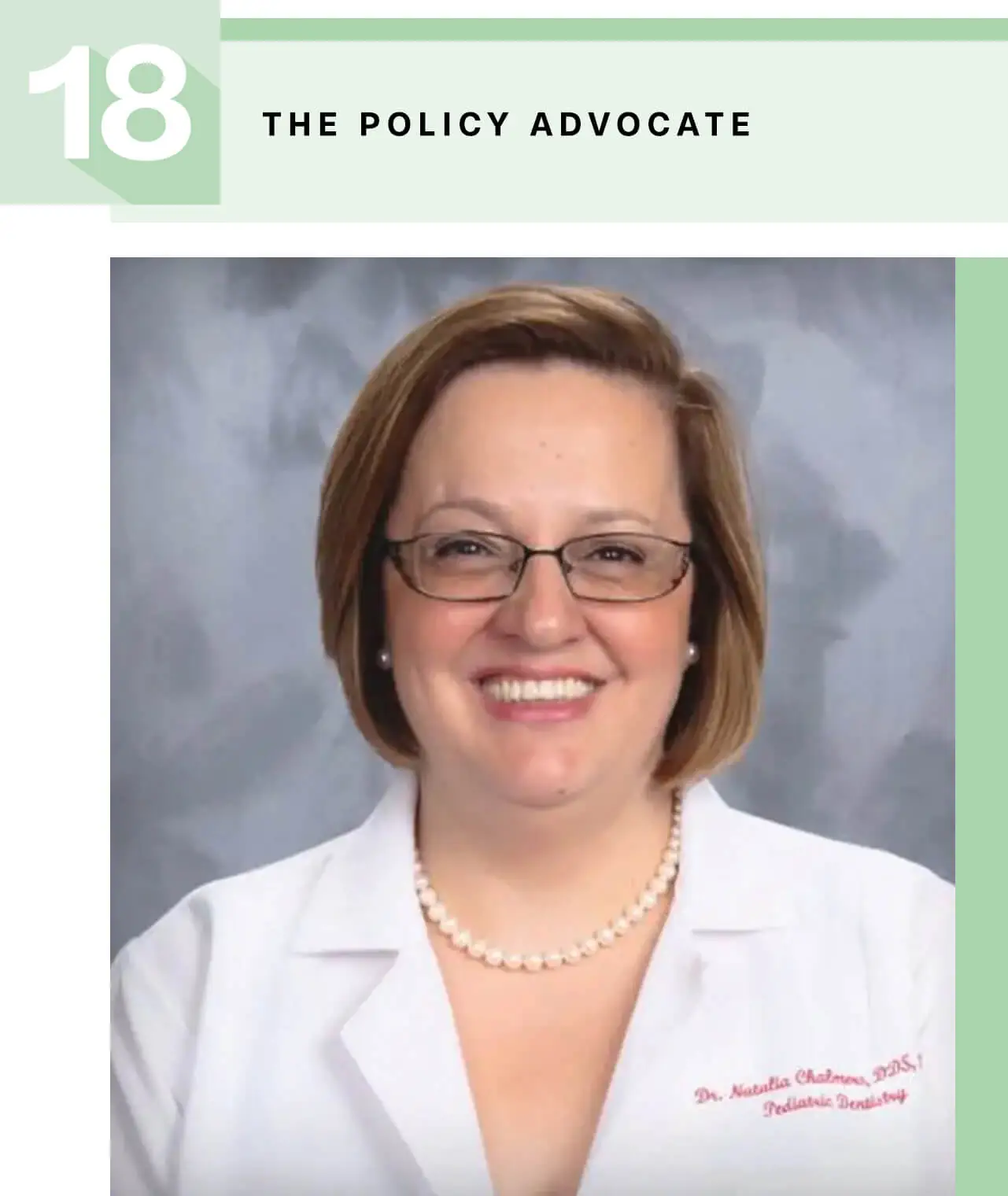
Natalia Chalmers
Chief Dental Officer, the Centers for Medicare and Medicaid Services
Silver Spring, Maryland
Last Year: 11
IT’S DIFFICULT TO start a new job; doing so is even harder when you’re the first person ever to hold a given position. That was the case for Dr. Chalmers, the Centers for Medicare and Medicaid Services’ inaugural chief dental officer when she took the gig in August 2021.
An expert in pediatric dentistry, oral health policy and public health advocacy, she applies her more than two decades of experience in clinical practice, research, industry and regulation to her position within CMS’s Office of the Administrator. The creation of her position, long advocated for by the American Dental Association, seems to underscore the importance of preventive care. That tenet seems like a no-brainer, but Medicare stubbornly does not cover preventive dentistry.
“Today, many people in the United States have fantastic access to oral health,” Dr. Chalmers says. “They call their dentist, make an appointment and get in right away. There are no issues or problems with access to care. But for others, you have disparities in access to care, so the combination of these two becomes really challenging.”
Will those challenges be met? Dr. Chalmers is still relatively new on the job. Turning the ship of state, or even nudging it a few degrees in any given direction, is always problematic—but we’ll be keeping an eye out to see what sorts of changes she might be able to effect.
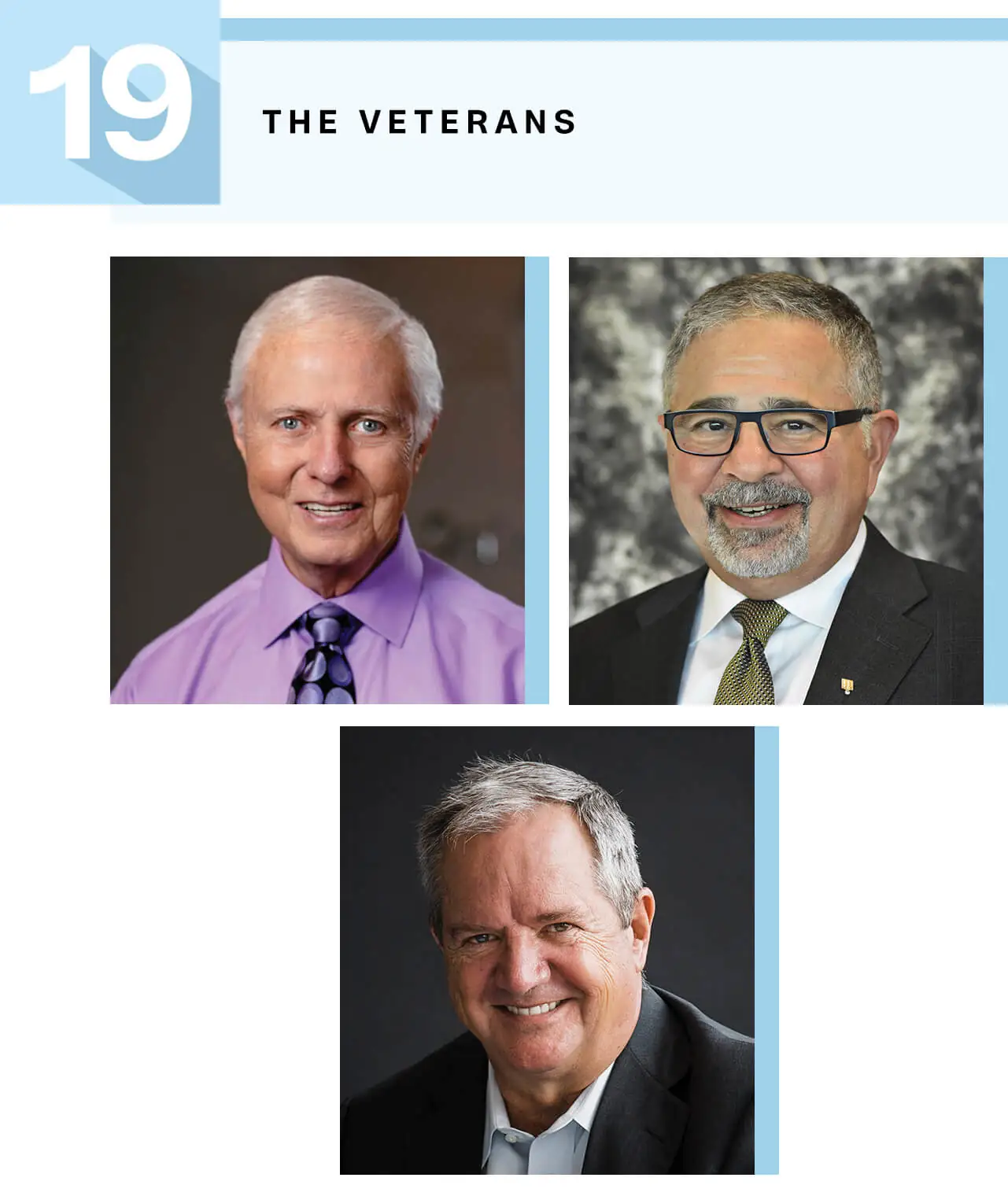
Gordon J. Christensen, John Kois and Frank Spear
Founder, Practical Clinical Courses; Founder and Director, The Kois Center; Founder and Director, Spear Education
Provo, Utah; Seattle; Phoenix and Seattle
Last Year: 20
THESE THREE candidates for dentistry’s Mount Rushmore deserve every career laurel that has come their way. But time waits for no man, and with an average age of 77, these titans are surely aware of the sands of the hourglass.
The still extraordinarily active Dr. Christensen is the elder statesman at 88; he remains vital in the service of product reviews through his monthly Clinicians Report, which debuted in 1976 and reaches roughly 100,000 dentists in more than 90 countries.
Dr. Kois, 74, founded the esteemed Kois Center in 1994, establishing it as a leading educational hub for advances in aesthetic, implant and restorative dentistry. Dr. Spear, 72, is active in his Seattle private practice, an adjunct professor in the University of Washington’s graduate prosthodontics program and a sought-after speaker at industry events.
What’s left to achieve? Well, the allure of simply keeping on keeping on can never be gainsaid, and this estimable trio certainly deserve the benefit of the doubt. We wish them many more years of health and professional success. They will surely remain on this list as long as they remain active.
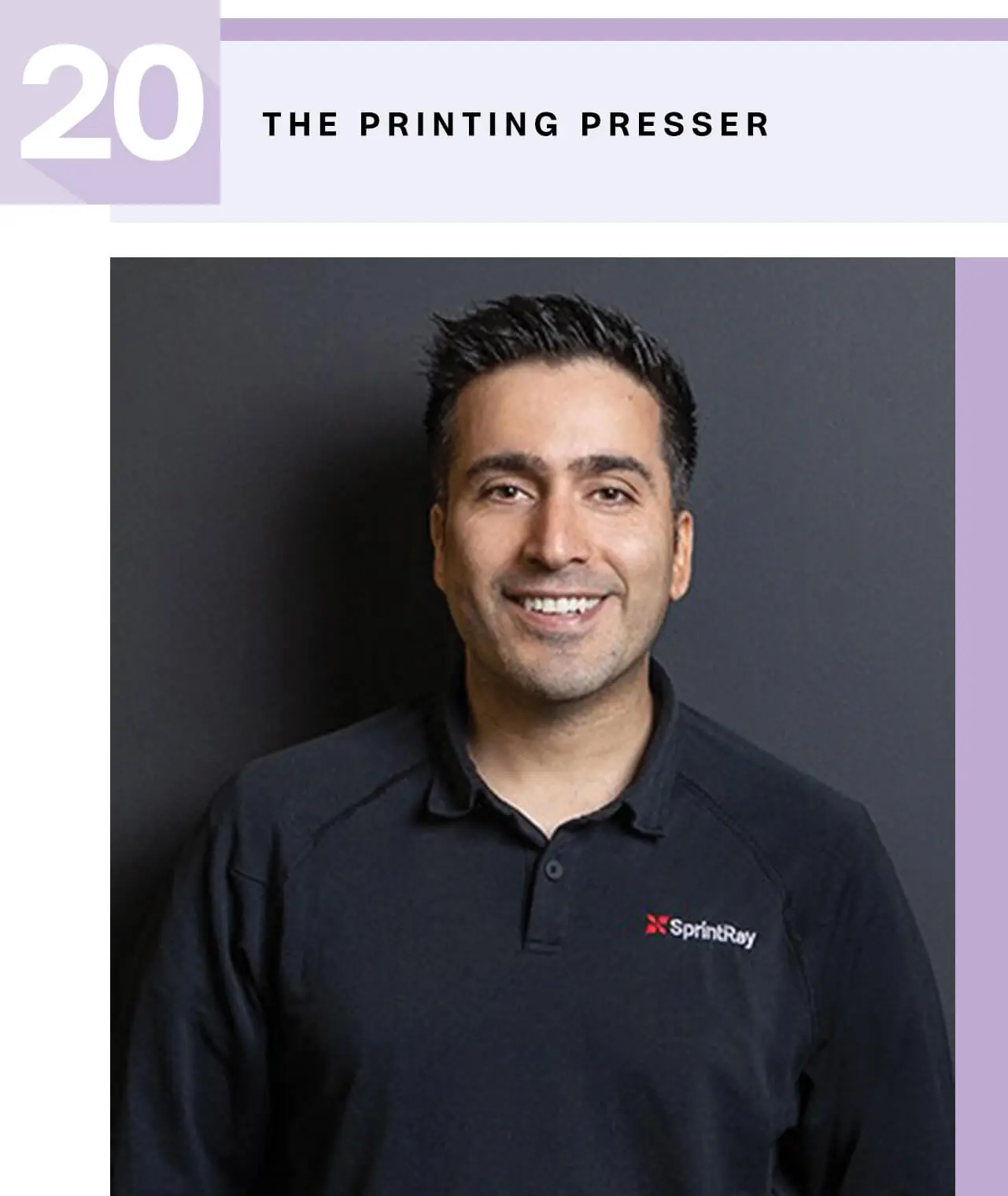
Amir Mansouri
Cofounder and CEO, SprintRay
Los Angeles
Last Year: 29
THE APEX OF today’s dental technology, arguably, is 3D printing, and SprintRay—the brainchild of engineering Ph.D. Mansouri—is, for now, the unquestioned leader in the space. While other 3D-printing companies have many plates spinning at any given time, SprintRay is the only one currently focused exclusively on dentistry.
The race to produce permanent 3D-printed crowns is at full throttle; the challenge is developing a material that lasts long enough in the mouth. SprintRay—which raised $100 million in its most recent funding round, in October 2022—has created a ceramic crown material, but doctor and patient uptake has been relatively sluggish so far.
Early last year, the company introduced its Ceramic Crown 3D Printing Ecosystem, enabling dentists to produce a crown for as little as $20. Price is only one variable, of course, but soon being able to charge many multiples of a crown’s manufacturing cost will no doubt be enticing. At its quarterly innovation roundup in April, the company released information about product upgrades, improvements to its cloud services and more, but crown information was scant. Certainly something to keep an eye on in the year ahead.

Simon Campion
CEO, Dentsply Sirona
Charlotte, North Carolina
Last Year: 26
REMEMBER WINSTON WOLF from Pulp Fiction, the ultimate problem solver played by Harvey Keitel? We can’t quote him much in this family publication, unfortunately, but we can compare him (favorably, we hasten to add) to Dentsply Sirona’s latest CEO, the fourth since Dentsply and Sirona consummated their—so far—mostly bumpy merger in 2016.
Sales have been largely flat in the years since, going from $3.99 billion in 2017 to . . . $3.92 billion in 2022. You don’t need an MBA to recognize that that’s the wrong direction—but while 2023 was not a turnaround slam dunk, Campion is bullish. “We delivered on our outlook, with three of our four segments posting year-over-year growth in the fourth quarter and full-year 2023,” he says. The numbers mostly bear him out: 2023 net sales of $3.97 billion increased 1.1 percent (organic sales increased by twice that), compared to full-year 2022. Net income was -$132 million (62 cents per share), compared to -$950 million ($4.41 per share) for full-year 2022.
So even though the company has lost money the last two years, the trend line is ostensibly headed in the right direction. Yet investors, by and large, still squirm; as of this writing the company’s stock—which carries the plucky Nasdaq ticker symbol XRAY—is near its 52-week low. Campion seems a capable steward amid a difficult job, but much work remains.
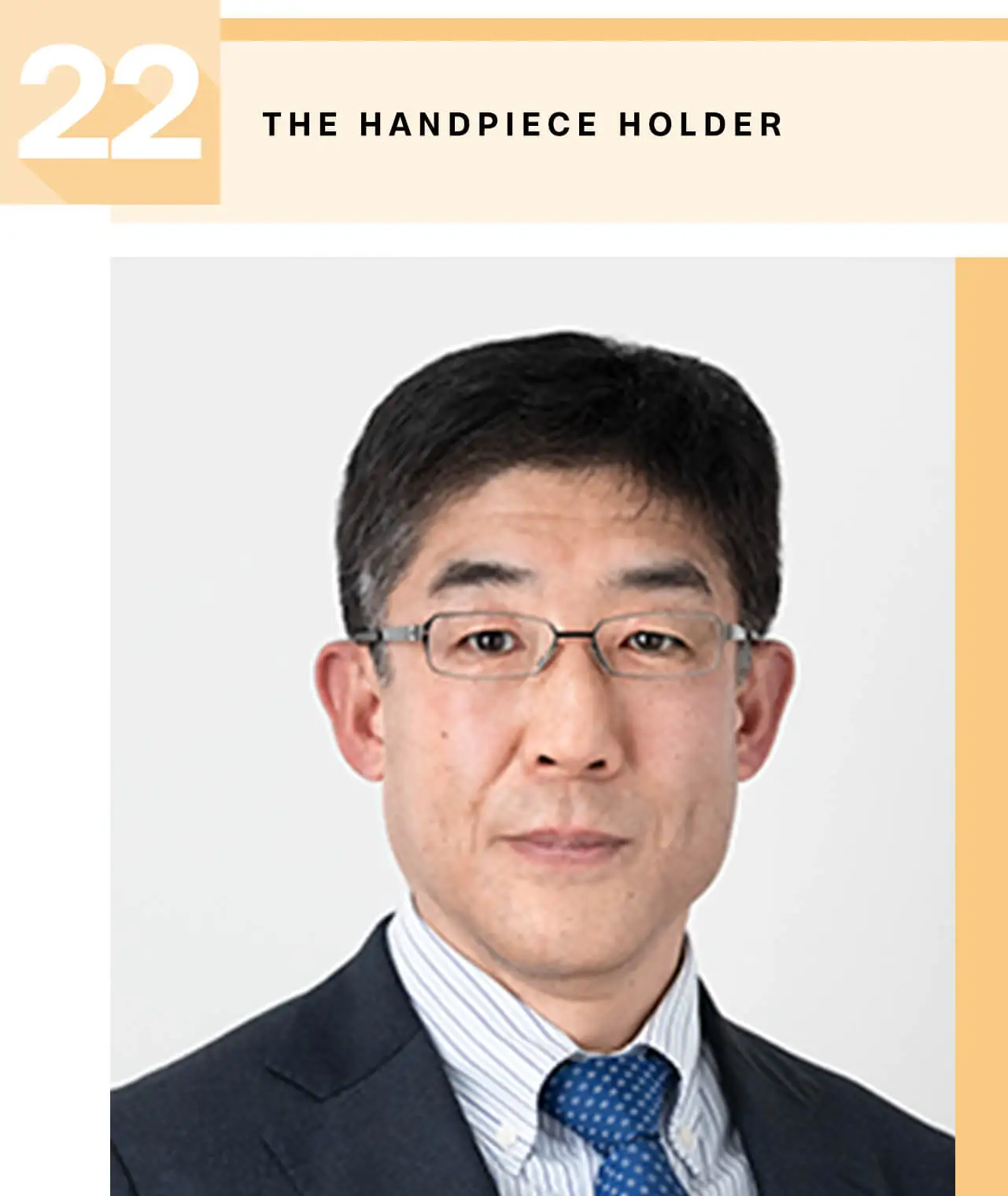
Eiichi Nakanishi
President and CEO, NSK/DCI
Tochigi, Japan
New
FOR NEARLY a century, Nakanishi Manufacturing (now NSK) has made dental handpieces. Eiichi Nakanishi is the third-generation owner of this Japanese concern that is now one of the world’s largest makers of air-driven and electric handpieces, as well as those for endodontics, surgery and hygiene, with a market share of around 28 percent. (It also makes dental chairs and related instruments.)
In 2023, NSK bought DCI, a four-decade-old dental equipment and parts manufacturer headquartered in Newberg, Oregon, which helped the parent company boost its U.S. sales by 29 percent and gives it a solid foothold in the West as what we estimate to be the top handpiece seller in the U.S. “This is a game-changing combination, which will provide both NSK and DCI with the broader solutions, customer reach and capabilities to solidify our position as a leading provider,” Nakanishi said at the time. “By bringing the two companies together, we will further heighten our strengths and provide our customers with the best possible experience.”
Well, that’s what they said at Dentsply and Sirona, too (see No. 21). But so far things at NSK, and for Nakanishi himself, seem to be working out just fine.
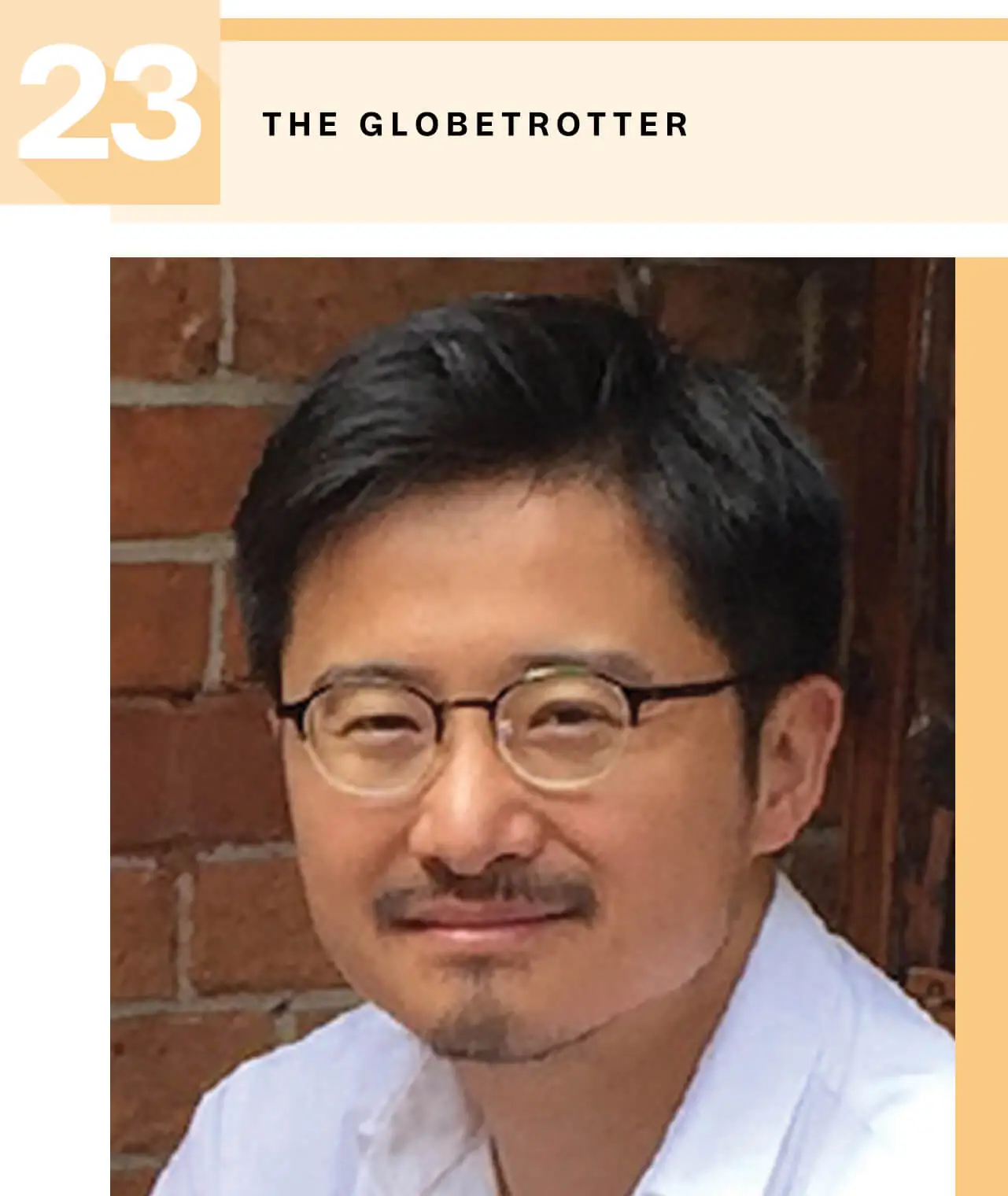
Dai Feng
Cofounder and Managing Director, CareCapital Advisors
Hong Kong
Last Year: 18
IN RECENT YEARS, this list has focused a little more than it ever used to—which wasn’t much—on the business of investing in dental businesses. In part this is because financing has become a bigger game of late (see Doug Brown, No. 4), and Feng’s CareCapital Advisors is one of the biggest players.
It invests in developing health care firms, with a portfolio—“in the multibillions” is as specific as it will get—that encompasses more than 50 enterprises in dental (among them Orthobrain, Carestream, Huggah and EasyDent), other medical services, health care software and wellness.
It operates across Asia (China, South Korea and Singapore), Europe (Spain, France, Germany and Sweden), North America (the United States and Canada) and the Middle East (Jordan). Feng and CareCapital are also active constructing dental hospitals, particularly in urban areas, with a focus on promoting the dissemination of American dental care standards in developing countries.
Feng was previously a partner at Warburg Pincus, a highfalutin private equity firm with a strong emphasis on medical technology. There for 11 years, he spearheaded health care investments in Asia, overseeing the growth of companies in fields such as cardiology devices, consumer health, plasma therapy and eye care. A medical man to his marrow, in other words, who is now focused on dentin and enamel.

Howard Farran
CEO, Farran Media, Dentaltown, Orthotown, Hygienetown
Phoenix
Last Year: 28
HELLO, OLD FRIEND! Dr. Farran was on the cover of Incisal Edge back in the Pleistocene Era, and he has been a fixture on this list (see “IE’s All-Time Most Influential”) since its inception. Because his presence here relies on the continuing influence of Dentaltown, the proto-social media community he founded in 1999, we keep asking the same question year after year: how long can it remain relevant? After all, countless media empires have fallen since the Clinton administration.
Yet Dentaltown continually weathers the challenges that legacy media face. Its user base is substantial, engaged and loyal. DentalTown tells us they have approximately 95,000 unique visitors per month, though traffic has waned a bit in recent months according to our in-house analysis. Its audience has also become younger and more female—a good sign in an industry that’s doing exactly the same thing.
Still, other young people—such as our selections for this year’s top student influencers—gravitate more to Instagram and TikTok. So why do Dentaltown and its offshoots—Orthotown and Hygienetown—keep chugging along? Credit the effervescent Dr. Farran and his watchful eye, not to mention his vibrant, wide-ranging podcast, Dentistry Uncensored, which remains fresh and of the moment. (Recent topics include empowering women, the science of sleep and “At the Crossroads of DSO vs. Private Practice.”) In other words, don’t count him out just yet.
CORRECTION: An earlier version of this item understated the number of unique visitors to Dentaltown.com.
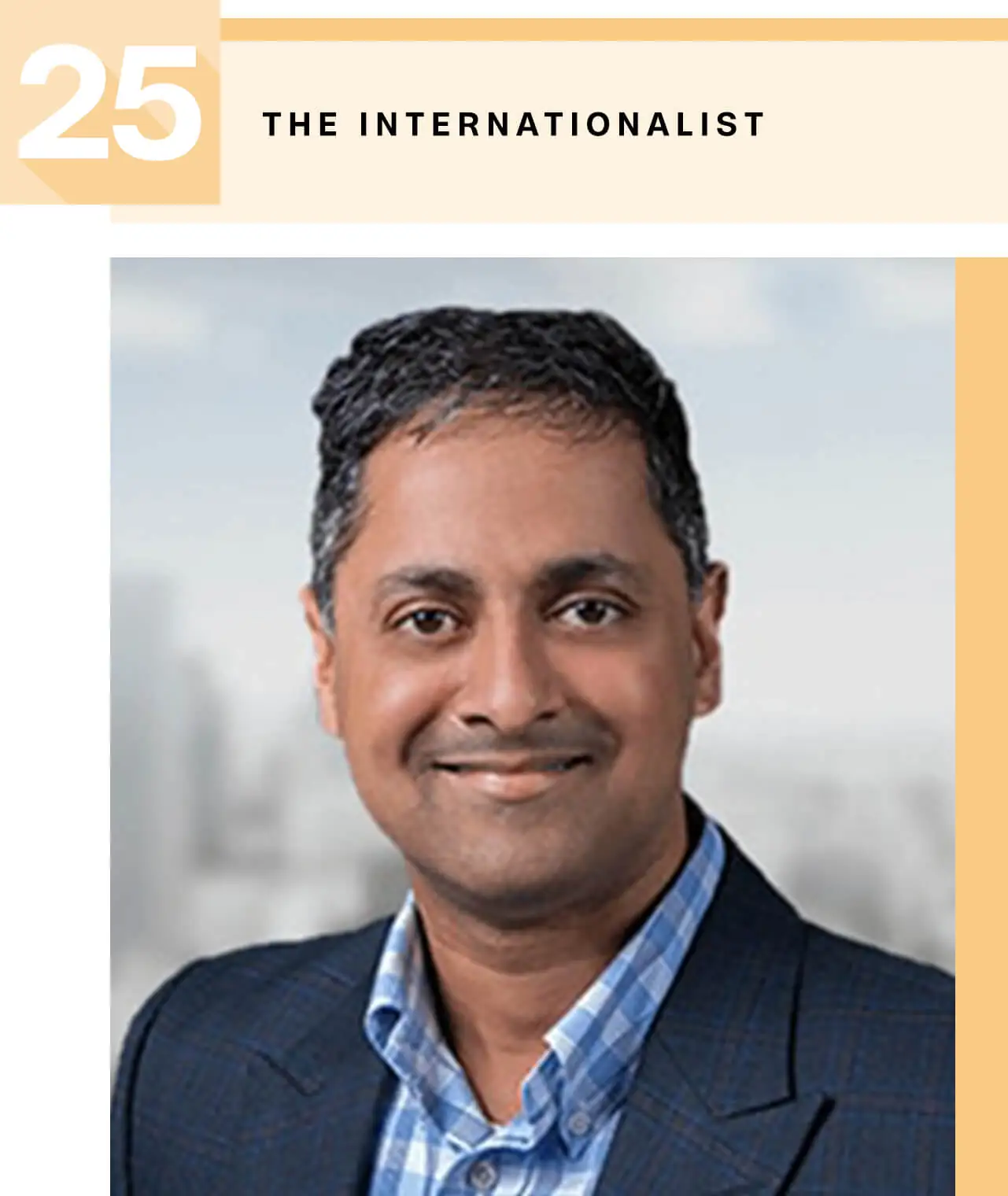
Ram Raghavan
President, Enterprise Oral Care, Colgate-Palmolive
New York
New
COLGATE’S U.S. mouth-share in toothpaste generally runs in a dead heat for dominance with Procter & Gamble’s Crest, recently (ahem) cresting 40 percent globally. That’s not even including other similarly successful products like manual toothbrushes and rinses. With that kind of penetration, the brand likely has more sway over patients’ at-home care than dentists do. And that makes Raghavan, a Colgate-Palmolive lifer, arguably the most influential executive of his ilk.
From his start as a trainee 27 years ago to his 2022 elevation to corporate president, Raghavan has a wide-ranging background in sales, brand management and marketing across India, China, Canada, Mexico and the United States. Most recently, he led C-P India as managing director through the pandemic, sustaining Colgate’s Nielsen ranking as the Subcontinent’s most trusted oral care brand. The Dartmouth MBA brings a powerful international perspective to his job, as well as a firm understanding of how innovation drives consumer behavior—plus, it seems, good intentions. He declined our interview request through a representative but told BrandEquity.com in 2020: “We consider it our responsibility as leaders to structurally elevate oral health.” —Edward Kobesky
“We consider it our responsibility as leaders to structurally elevate oral health.” —Ram Raghavan
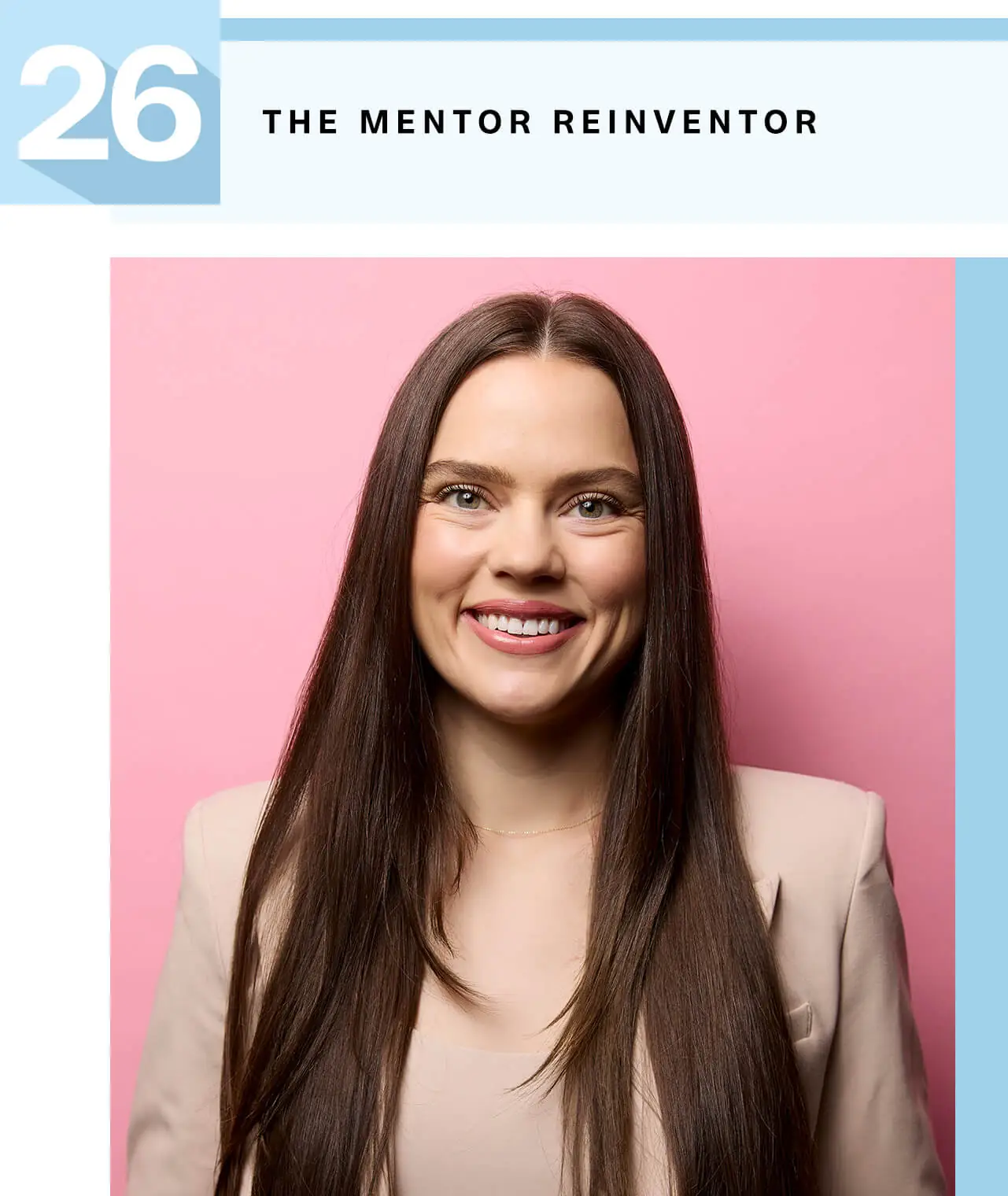
Brittany Glauz
Hygienist, Podcaster, Rising Social Media Star
San Diego
New
THIS ISSUE’S cover star knows her audience. Why? Because she is her audience. She launched her podcast, Brush With Britt, in October 2020 while she was in hygiene school. “I was looking for a mentor, somebody online who was talking about the rough parts of school, and I couldn’t really find one,” she tells Incisal Edge.
Today, Glauz has become the mentor she was once desperate for. In doing so, she has also laid bare a truth about the hygienist’s journey: While there’s a lot of support out there, it’s often not the kind her generation is looking for, and it doesn’t always exist in the places they typically look. Her influence is helping to change that, which the numbers bear out: Glauz has amassed more than 75,000 followers on Instagram, and some of her Reels have millions of views. She has another 100,000 followers on TikTok.
You can see the void she’s successfully filling simply by browsing her podcast topics: six tips for starting school, finding patients, balancing work and classes, your first week on the job, “grief literacy” and how to ask for a raise. That last one is particularly personal. She recalls moving to a new city while working as an assistant prior to becoming a hygienist. “I had no idea how much to ask for. It wasn’t until years later that I found out how badly I lowballed myself. That’s exactly the kind of thing no one was talking about.” We’re not the only ones noticing her chops: She was the sole U.S. winner in 2024’s World Dental Hygienist Awards, presented by Sunstar Oral Health in partnership with the International Federation of Dental Hygienists.
Glauz is a hardworking one-woman band, so naturally she tries to monetize her platforms. However, she says, “I really do limit it because I feel that part of the success of my platforms comes from showing up authentically and genuinely. Money was never the goal.” She invests countless hours replying to all her DMs and emails personally and plans to keep tackling increasingly advanced and sometimes uncomfortable topics. “A hygienist when I first started told me that the biggest impact you can have comes from teaching other hygienists. That always stuck with me.” —Edward Kobesky
“A hygienist when I first started told me that the biggest impact you can have comes from teaching other hygienists. That always stuck with me.” —Brittany Glauz

Karim Mansour
President, Dental Solutions, Solventum
Paris
New
SOLVENTUM’S SPLIT from 3M in April was more than just a name change; it was one of the biggest spin-offs of its kind. Last year, the portion of the business that is now Solventum (so named for its promise to “never stop solving” for customers) generated $8.2 billion in revenue. It seems like a slam dunk: The new company has a great existing product portfolio, plus a leadership team that mixes sharp newcomers like CEO Bryan Hanson with established 3M veterans.
But what will happen to the dental products division, with its bigger spotlight in this new company? In large part, that’s up to Mansour, another transplant who brings 25 years of 3M experience with him. All seems right with the world—except spins like these can be difficult, as we saw when Danaher spun out Envista as a dental-only company.
Still, in the near term, there’s nothing destabilizing in sight, nor any unusual headwinds. Mansour, sensibly, is banking on the company’s strong foundation not only for immediate financial stability, but also as a launchpad for tomorrow’s innovations. “We have unmatched science at our core, giving [Solventum] unique leverage for product development,” he tells Incisal Edge. “While it will take time to unlock our full potential, we’re a new company with a long legacy of creating breakthrough solutions for our customers’ toughest challenges. We have global presence in both dentistry and orthodontics, and are well-known for our domain knowledge and science.”
The culture, it seems, has largely carried over as well. Mansour says the company will continue to focus on five pillars: science, innovation, customer insights, global reach and corporate citizenship, which all boils down to giving customers what they want, the way they want it. Listening to dentists, too: With feedback rolling in from users across 90 countries, Solventum has access to a rich trove of data from which to refine current offerings and help develop new ones.
What does it all mean for dentists? Single-minded focus, perhaps, since Solventum deals with dental materials and is no longer part of a larger entity that also pours resources into products like Scotch tape and sticky notes. “We have the expertise to approach oral care holistically, with products that address a broad spectrum of needs throughout a lifetime,” Mansour says. —Edward Kobesky
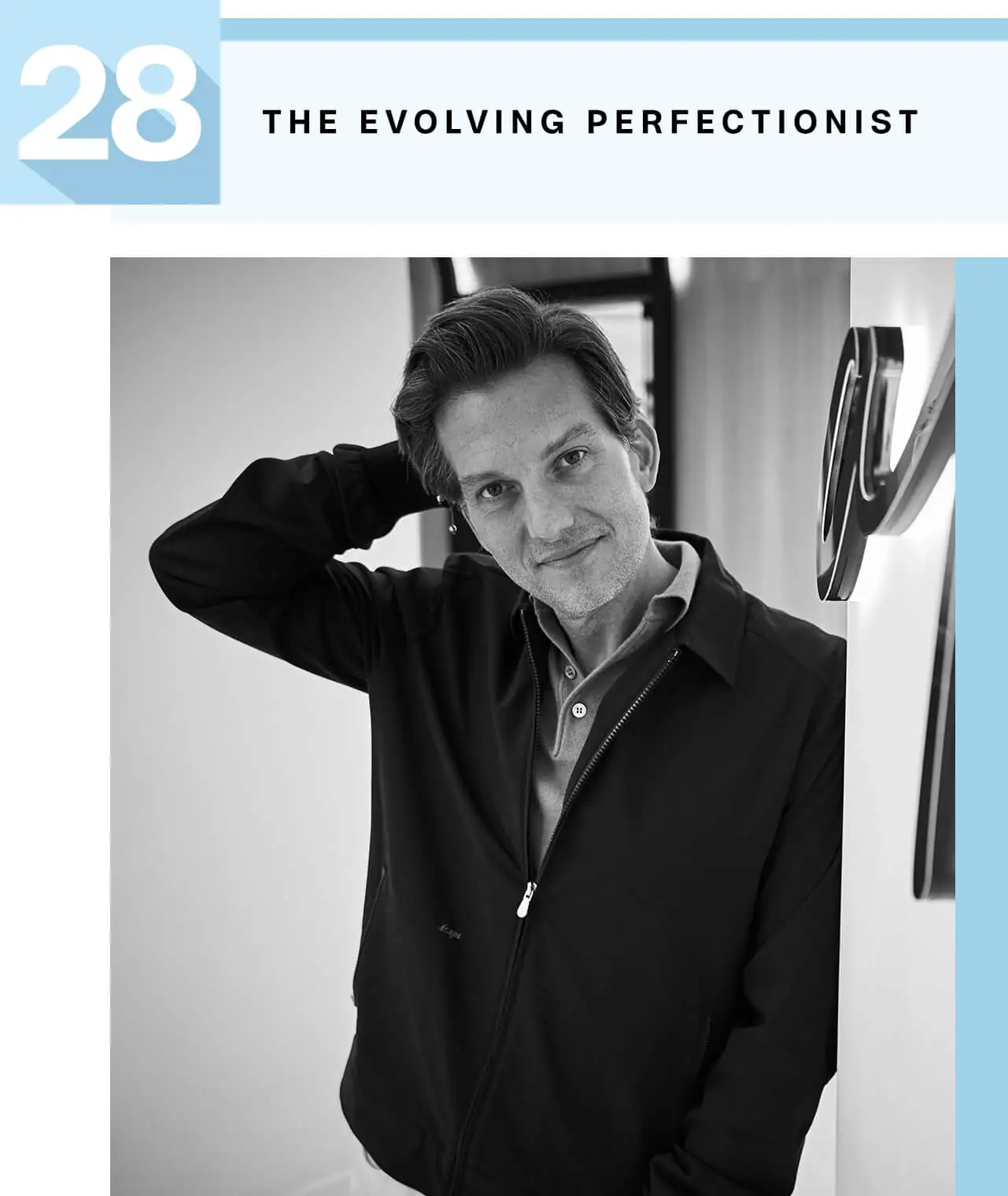
Michael Apa
Cosmetic Dentist, One-Man Megabrand, Educator, Philanthropist
New York, Los Angeles, Miami, Dubai
Returnee
WHEN DR. APA last appeared on our list in 2020, we acknowledged his influence as both as a boundary-pushing clinician and a public figure advancing public perceptions about dentistry. Today, while he maintains the same youthful energy, he’s embracing the (very) early days of an inevitable transition. One day, he’ll be an elder statesman in a rarefied category of dental entrepreneurship he largely defined: that of the obsessively perfectionist cosmetic dentist as an all-encompassing personal brand. And who he is these days is someone increasingly dedicated to helping others succeed.
He’s partnering with his alma mater, New York University’s College of Dentistry, to transform its aesthetics education with a clinical learning space and a new honors program that will bear his name, with the ultimate goal of offering an accredited fellowship. He also pledged a groundbreaking investment in City University of New York’s School of Public Health to establish a master’s program in oral health for dentists and any health care workers who will be making important oral health policy decisions. (He kickstarted this with a donation of a supporting scholarship fund for ten students.) Dr. Apa’s social media growth is no longer exponential, which feels intentional. His team estimates his Instagram reach has increased by about 20 percent since 2020, to 603,000 followers, as he devotes a bigger share of his bandwidth to connecting more meaningfully with current patients and aspirational followers.
Yet he’s also far from a day when there will be nothing new left to achieve. Apa Aesthetic’s new Miami location opened in February. Two collaborations mark his entrance into the fashion world: John Geiger x Apa Aesthetic, which distills the disparate duo’s perfectionist creative energies into a sleek but attainable high-end sneaker, and L’Atelier Forte, a luxury health care office attire company where Dr. Apa will have a hand in design. There’s also a docuseries in the works, because, at this point, why not start sharing the secrets of his success? That’s what legacy building is all about. —Edward Kobesky
Two collaborations mark his entrance into the fashion world: John Geiger x Apa Aesthetic, which distills the disparate duo’s perfectionist creative energies into a sleek but attainable high-end sneaker, and L’Atelier Forte, a luxury health care office attire company where Dr. Apa will have a hand in design.
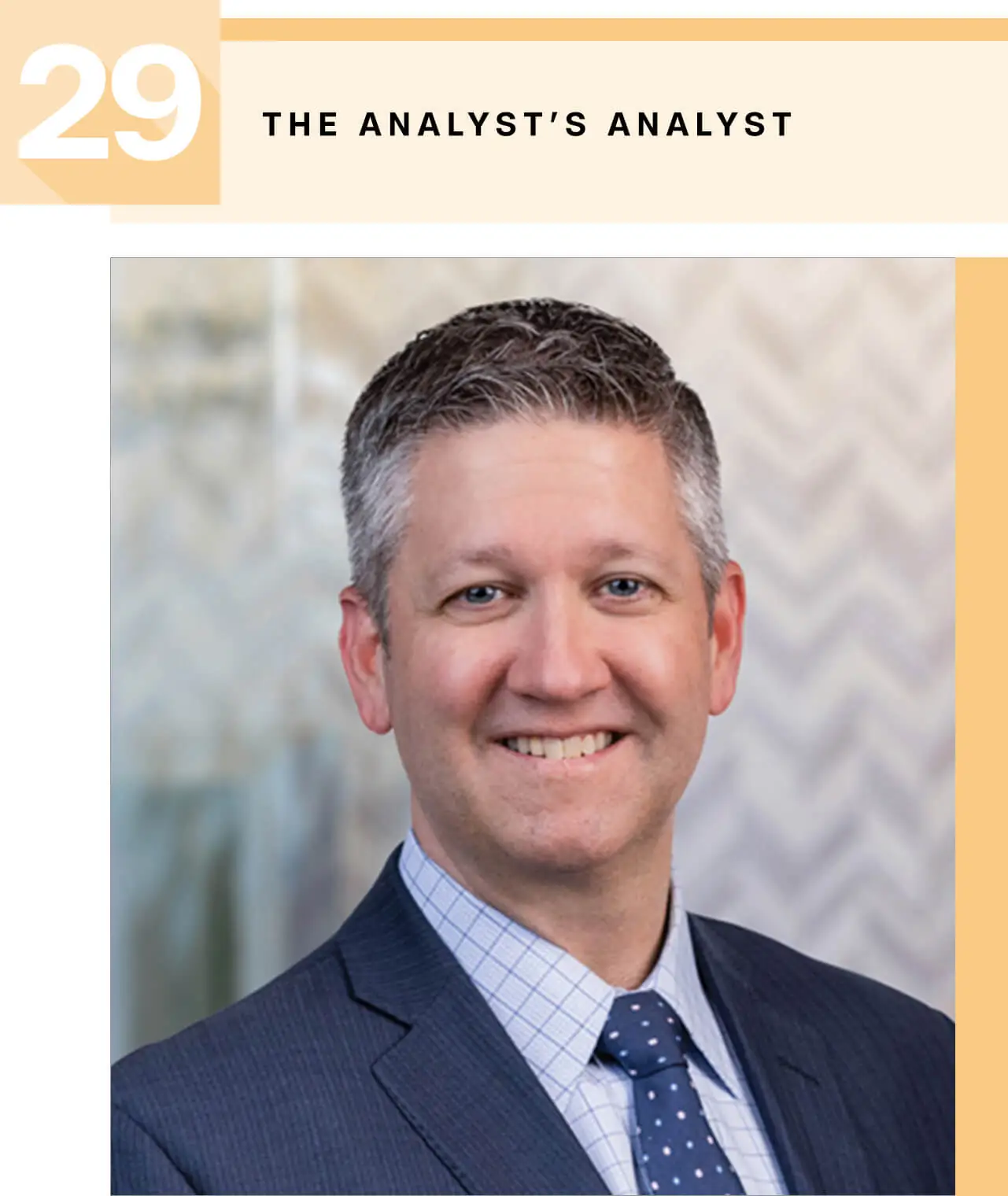
Jeff Johnson
Senior Research Analyst, Medical Technology, Robert W. Baird & Company
Milwaukee
Last Year: 32
EVERY YEAR WE check in with this list regular, dentistry’s most seasoned analyst, for his take on the industry—this year, specifically, on some of the biggest public companies.
“Henry Schein has long been one of the best executors in the space, and Stanley Bergman [No. 5] has long made so many right decisions. It has been impressive to watch them recover as well as they have from their cyber-intrusion in 2023. They’ve clawed back a lot of that business.
“As for Align, there were so many orthodontic cases, including clear aligner cases, done in 2021, when everybody was sitting at home on Zoom. Then 2022 was kind of a year of digestion. In 2023, orthodontics and clear aligners were again kind of flat.
“Patterson has had a good run over the last couple years, especially on the consumables side. There’s a bit of turnover there that we’re watching. With the recent departure of PDCO’s dental president, the second change in that position in less than three years, there’s some uncertainty [regarding] who may be leading that organization going forward.
“Envista has done very well in the clear aligner market, taking market share in the last couple of years with their Spark product. That’s been the darling of the portfolio, for sure.
“The management team at Dentsply Sirona is taking the next five or 10 years’ view to get the company back on the right track. It’s still early days, and there’s still some messiness, but they’re confident they’re on the right track for the long term.”
Finally, Straumann, helmed by this year’s No. 1, Guillaume Daniellot. “They used to be 100 percent dedicated to premium implants, but then back a decade ago they saw—ahead of others—that there was probably going to be a move in Europe toward lower-priced implants. They bought up a lot of the best assets in that mid-tier implant category. It’s in these kinds of markets, when dentists are a little more sensitive to price, that they’ve got the right products at those price points. So they’ve been well-positioned over the last decade for where the industry has moved.”
“Envista has done very well in the clear aligner market, taking market share the last couple of years with their Spark product. That’s been the darling of the portfolio, for sure.” —Jeff Johnson
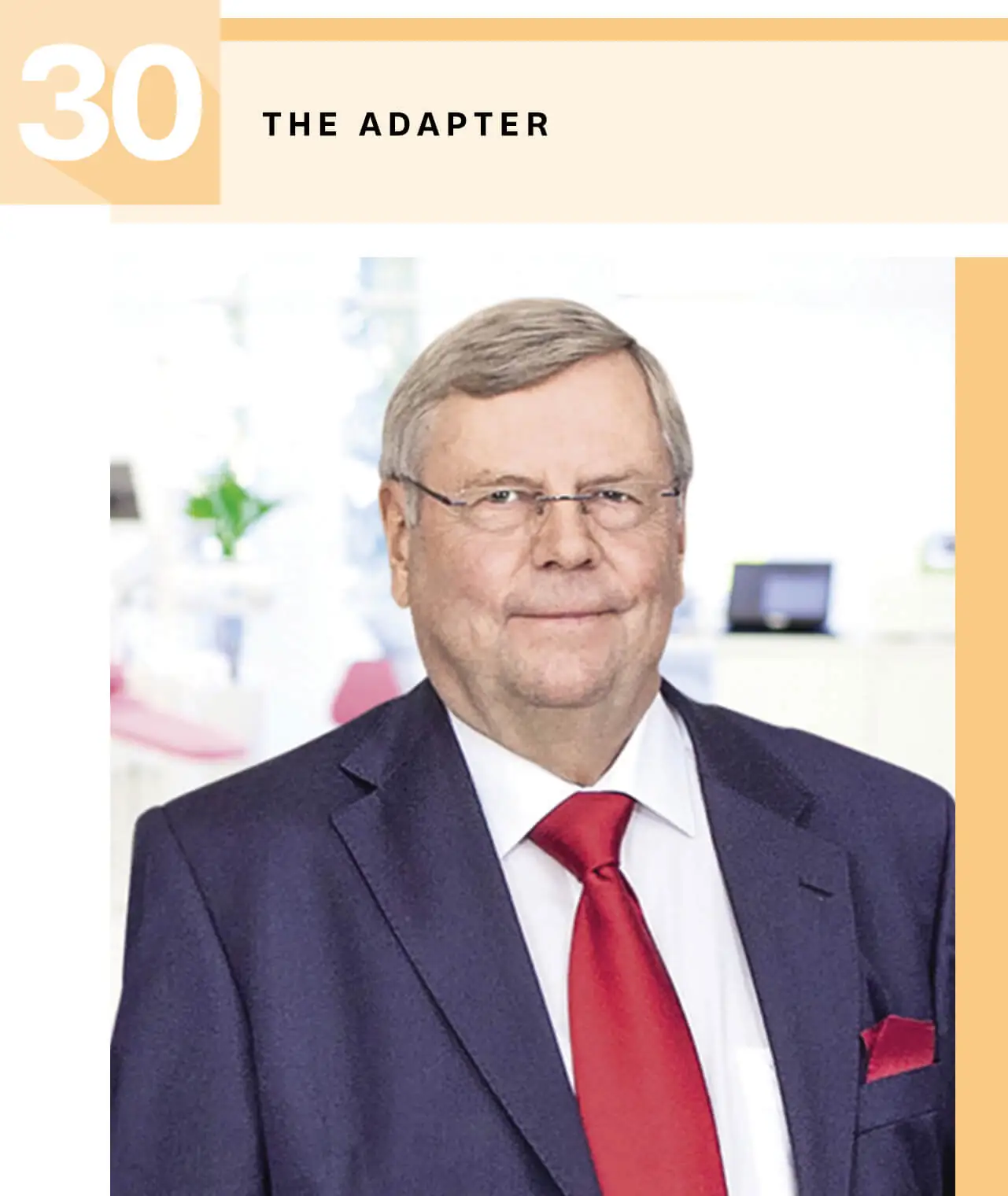
Heikki Kyöstilä
CEO, Planmeca
Helsinki, Finland
Last Year: 22
“MIGHTY OAKS from little acorns grow” is a proverb that has been attributed to, among others, Geoffrey Chaucer. We have no idea how that translates to Finnish, but it applies in spades to industry giant Planmeca, founded by Kyöstilä in 1971 as a maker of dental stools and cabinets. It’s now the world’s largest privately owned dental manufacturer, employing roughly 4,600 people around the globe and generating around $1.3 billion in annual revenue. It became an even bigger powerhouse when it bought Envista’s KaVo division in 2021.
Its development over the past five decades, meanwhile, has mirrored that of the industry at large:
- By the end of the 1970s, the company had branched out into dental chairs and full dental units.
- In the ’80s, Planmeca started adding microprocessors to its equipment.
- In the ’90s, it added digital imaging.
- The 2000s saw the expansion of imaging, including Cone Beam technology and other imaging software.
- In the 2010s, Planmeca then enhanced its imaging systems to be able to create a three-dimensional virtual patient.
The 2020s have brought further technological advances, of course, which has given Planmeca the opportunity to expand its reach still further. Whether he’s dealing in ordinary stools or the furthest reaches of techno-futurism, Kyöstilä is keeping himself, and his steady infuence, at the forefront of dentistry.
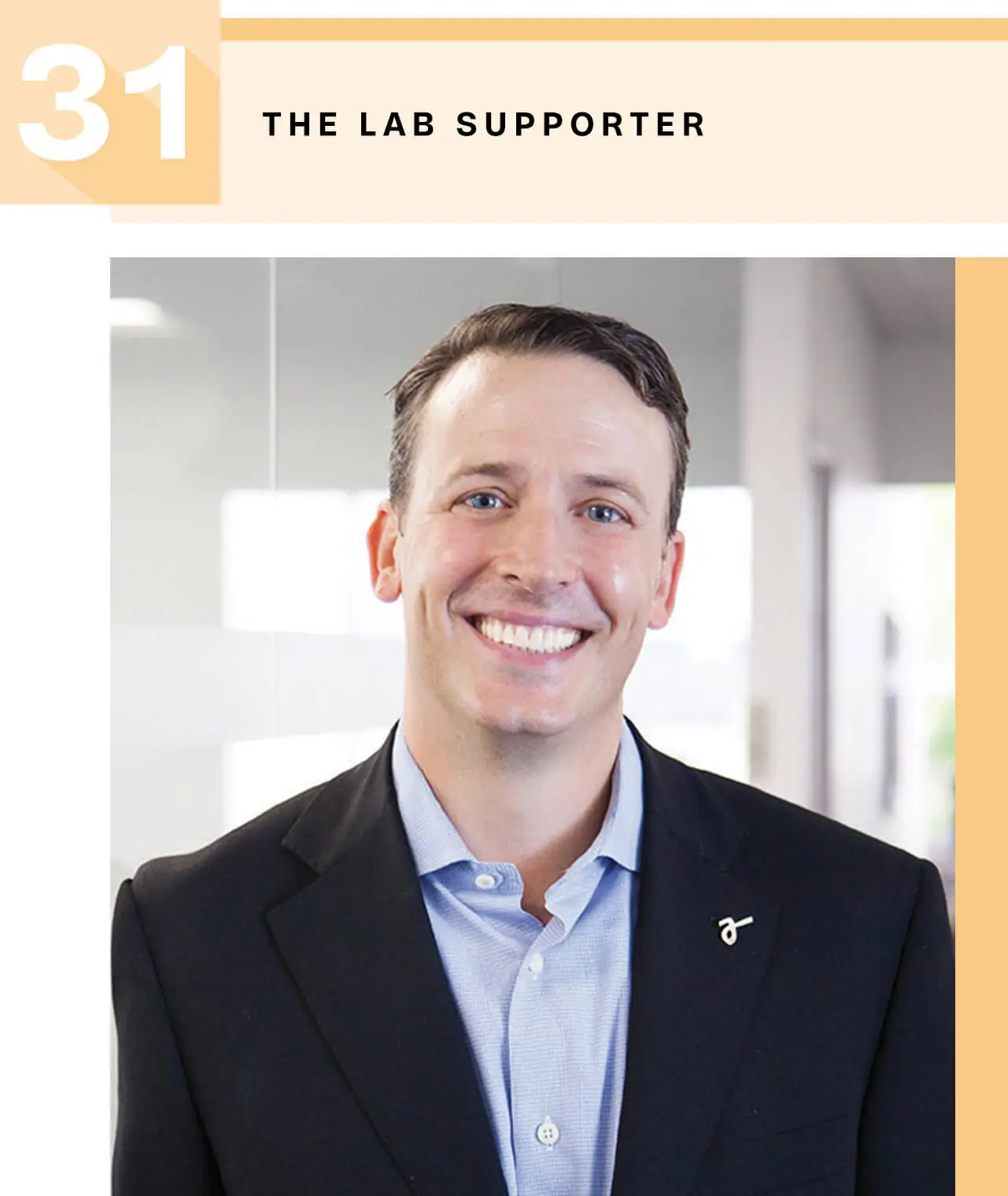
Anton Woolf
CEO, Argen
San Diego
Last Year: 31
LOW-PROFILE but innovative as all get out: That’s not a bad niche in which to stake your claim. Argen is, not to put too fine a point on it, small dental labs’ rocket fuel, giving them the tools and resources they need to stay relevant and grow amid much larger competitors.
Woolf has been CEO since 2008, six years after Argen became America’s largest manufacturer of precious dental alloys and three years after it did the same worldwide. He has kept the pedal to the floor, opening its digital outsourcing center, Argen Dental, in 2011. These days it’s growing beyond its roots in metals.
“People still look at Argen as an alloy company, and we’re no longer just an alloy company,” he says. “We still do alloy very well, but that’s actually a smaller part of our business today. People also see us as a digital outsourcing business, but we’re really also a zirconia manufacturing company.” Need further proof? Look no further than the bottom line: “In the fourth quarter of [2023],” Woolf notes, “we sold more zirconia discs than ounces of precious alloys.”
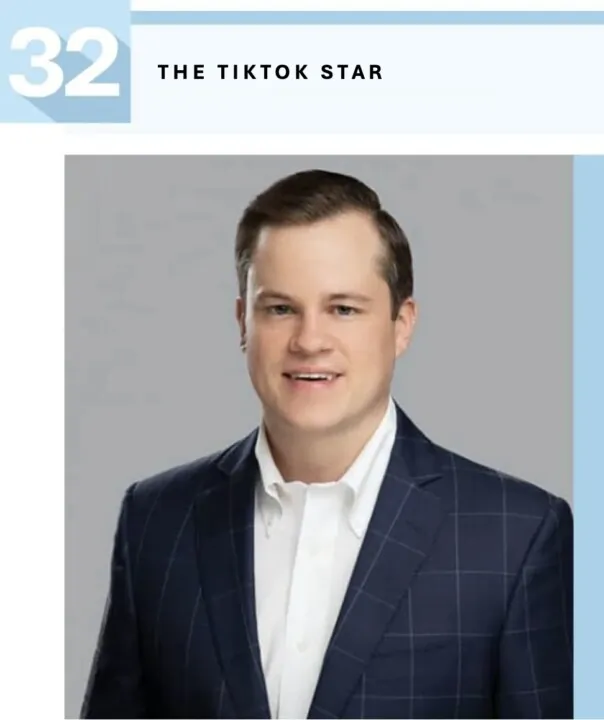
Jett Puckett
Partner, McLerran & Associates Practice Transitions
Atlanta
New
IT MIGHT NOT be the career trajectory he expected when he was getting his MBA at Wharton, but Puckett is internet-famous thanks to his spouse—but not (mostly not, anyway) in a Kardashian-husband sort of way. His wife, Campbell, better known as “Pookie,” is one of TikTok’s hottest current influencers (@campbellhuntpuckett, 1.1 million followers); he plays straight man and loving hubby while she shows off her wardrobe, documents their date nights or goes to a Formula 1 race.
In his off-social media time, the Puckett with the Y chromosome is a partner at McLerran & Associates, an Austin-based mergers & acquisitions firm that acts as an advisor and advocate for dentists considering DSO affiliation or looking to sell. He got his start in investment banking at Citi and later H2C Securities, offering health care mergers-and-acquisitions guidance.
And even if the guidance he gives these days isn’t limited to his 9-to-5 but also encompasses advising his wife on outfits and hairspray application, well, his quasi-celebrity has to goose McLerran’s brand equity at least a little. Fame comes in many strange forms these days, turning Andy Warhol’s classic 15-minute maxim on its head. The Pucketts are living proof, after all—and perhaps some of their good fortune will rub off on the dentists Jett counsels during the course of his day job. ■
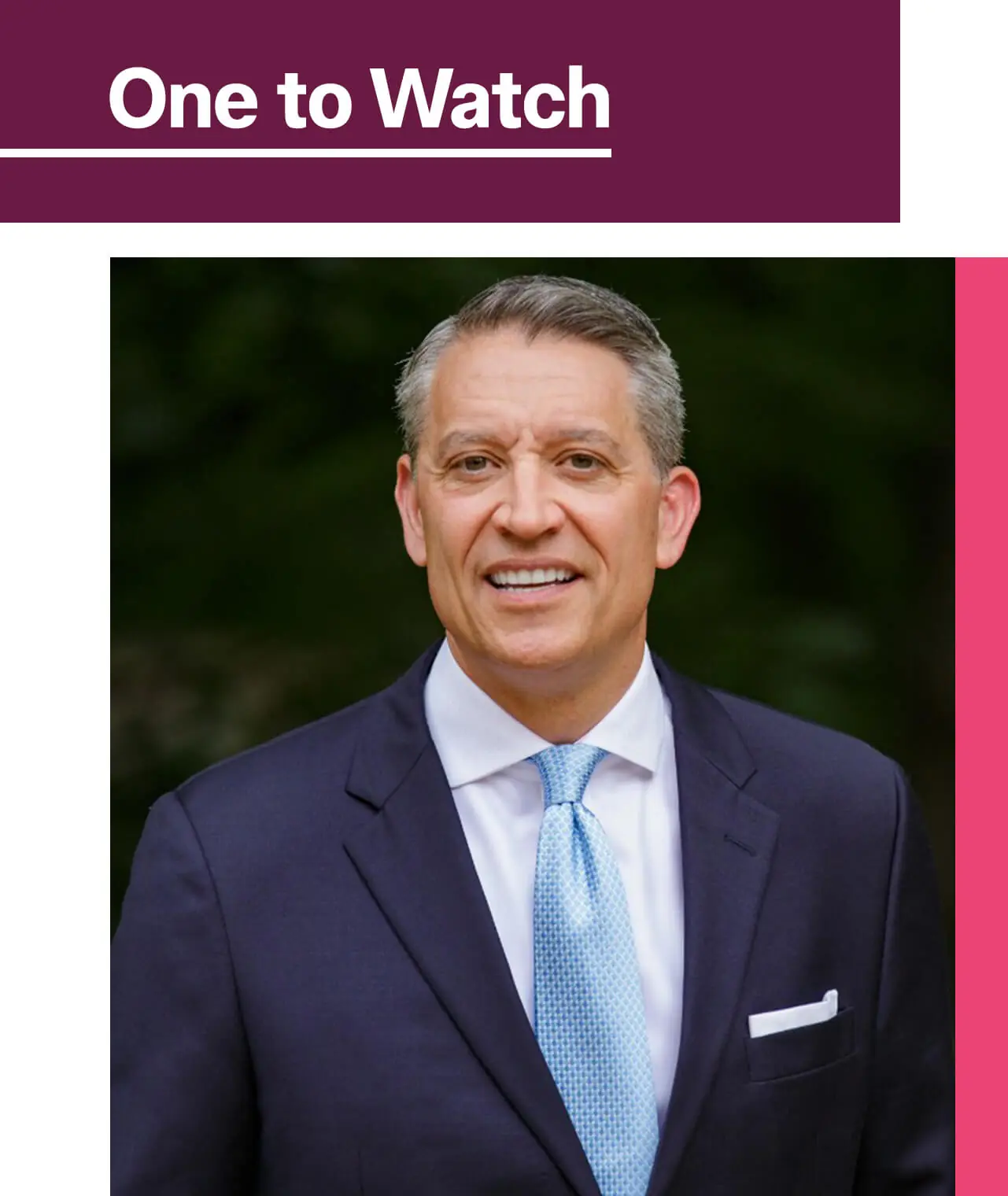
Paul Keel
CEO, Envista Holdings
Brea, California
EVER SINCE ENVISTA was spun off from Danaher in 2019, the company behind more than 30 highly respected brands including Nobel Biocare, Dexis and Kerr, “[has] yet to reach an inflection point,” according to outgoing CEO Amir Aghdaei in a press release announcing first-quarter 2024 financial results. That’s fine, since Aghdaei always maintained a sharp focus on product innovation. But investors, well, their focus is elsewhere, and the company’s stock tumbled to a new 52-week low as of press time.
Enter Paul Keel, appointed Envista’s new CEO in May. Can he continue building on the company’s enviable product offering while also preparing it for what investors might describe as a long-overdue liftoff? He has the background—and the incentives.
Keel previously spent nearly two decades in various roles at 3M, including as president of its Specialty Dental business. After roughly three years abroad running Smiths Group plc, a London-based tech company that’s listed on the FTSE 100, we imagine he’s happy to be back home in the United States and keen to stay. But perhaps most compellingly, he also stands to earn a cool $9.25 million in cash and other compensation over the course of his first year on the job, according to the Financial Times . . . if he hits his performance targets. —Edward Kobesky

Has Appeared Eight Years
Gordon Christensen, Practical Clinical Courses
Howard Farran, Dentaltown
Michael Graham, American Dental Association
John Kois, The Kois Center
Seven Years
Amir Aghdaei, Envista
Stanley Bergman, Henry Schein
Frank Spear, Spear Education
Steve Thorne, Pacific Dental
Marko Vujicic, ADA Health Policy Institute
Anton Woolf, Argen
Six Years
Robert Fontana, The Aspen Group
Joseph Hogan, Align Technology
Jeff Johnson, Robert W. Baird & Company
Rick Workman, Heartland Dental
Five Years
Guillaume Daniellot, Straumann
Four Years
Michael Cohen, Seattle Study Club
Bill Dorfman, Dentist and Multimedia Influencer
Rena D’Souza, NIDCR
Wardah Inam, Overjet
Kathleen O’Loughlin, American Dental Association
Three Years
Don Casey, Dentsply Sirona
Peter DuBois, California Dental Association
The Entrepreneurial Dentist
Marco Gadola, Straumann
Jim Glidewell, Glidewell Labs
Stephenie Goddard, Glidewell Labs
Paul Gosar, U.S. Representative
Bete Johnson, CareCredit
Parag Kachalia, Seattle Study Club
Heikki Kyöstilä, Planmeca
Roger Levin, The Levin Group
Mike Simpson, U.S. Representative
Martha Somerman, NIDCR
Where Did They Go?
Some of the highest-profile notables who often show up
on the 32 Most Influential list are absent in 2024. Here’s why.
 Victoria Yu
Victoria Yu
Former Chief Dental Officer, Walmart Health
Last year: No. 8
Not long ago, Walmart Health, the division of Walmart that provides medical services inside stores, announced it would open 28 new centers, bringing the total number of locations to more than 75 from just one in 2019. The company abruptly shifted gears on April 30, announcing the decision to shutter all centers instead because “there is not a sustainable business model for us to continue,” according to a press release. That leaves Dr. Yu, who previously served as chief clinical officer at the DSO Mid-Atlantic Dental Partners, out of a job—and patients and providers similarly displaced. It’s unreasonable to suggest that Dr. Yu alone could have done anything to save the initiative; even an exponential uptick in demand for dental services would represent only one revenue stream among primary care, behavioral health, labs, X-rays and hearing. But it appears Walmart is out of the dental business for good. And if Sam Walton’s behemoth couldn’t make it work, no one else in the beleaguered retail industry likely can either. Unless Amazon wants to give it a try—but we suspect they’ve seen enough at this point to know better.
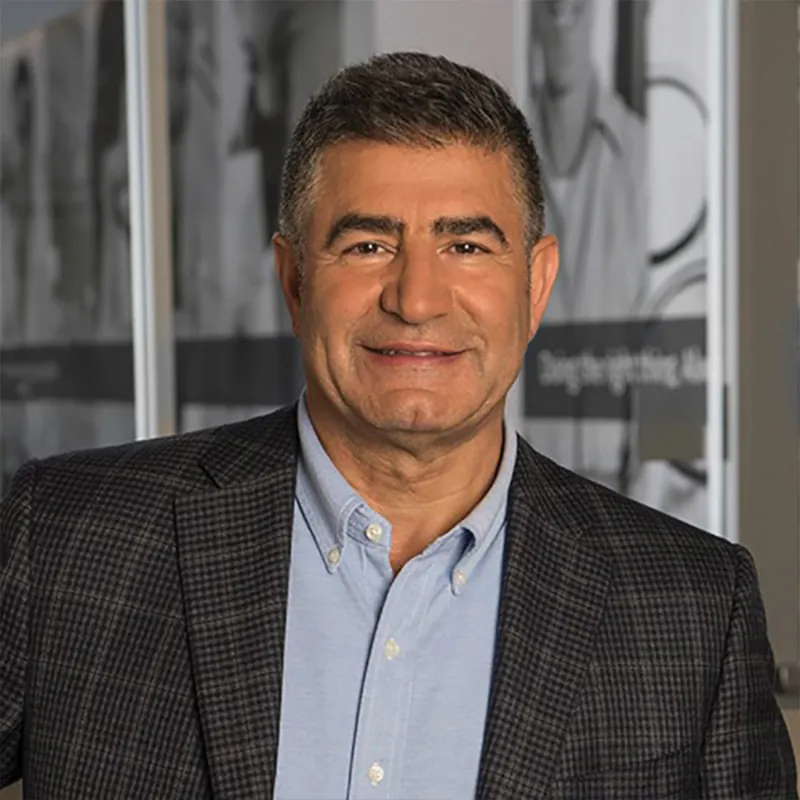 Amir Aghdaei
Amir Aghdaei
Former CEO, Current Senior Advisor, Envista Holdings
Last year: No. 15
There’s a good reason why Aghdaei, who passed the torch to a new CEO in May, has appeared on our list seven of its eight years: He’s not afraid of bold moves and big deals—on both the buy and sell sides. “Between 2004 and 2014, we acquired over 30 of the best dental companies in the industry,” he says. That solid foundation “gave us the opportunity to launch Envista as a separate, publicly traded company.” His May retirement marked the end of a swashbuckling executive career that peaked with that 2019 spin-off from Danaher, which he led since 2015. In just the last few years alone, Envista sold its KaVo Treatment Unit & Instrument business to Planmeca (for $383 million) and picked up Carestream Dental’s scanner business for $600 million, rebranding it as Dexis. The company’s current portfolio includes brands like Nobel Biocare, Kerr, DTX Studio and many others.
“We realigned our portfolio to focus on the fastest-growth and highest-margin segments of dental,” Aghdaei says. That meant focusing on implantology, orthodontics, diagnostics and consumables. There have been ups and downs since, driven in part by the pandemic and inflationary pressures, but Envista under Aghdaei largely maintained the confidence of investors and its strong position in the market, with a reasonable debt load relative to earnings.
During his tenure, he was also instrumental in launching the nonprofit Envista Smile Project, did volunteer teaching at the University of Southern California and other institutions, and advised the University of Chicago and High Point University. In fact, his next chapter will look a lot like his extracurricular Envista activities. “I plan to focus on the academic world by teaching strategy and leadership. One of my first jobs in life was as a math tutor to high-school students.”
For dentists and dental professionals, Aghdaei’s legacy is tied more to Envista’s products like Dexis imaging, Kerr endo, Nobel implants, Ormco ortho and Spark clear aligners, and he’s rightly proud of them. “What we do matters in improving quality of life for people around the world,” he says.
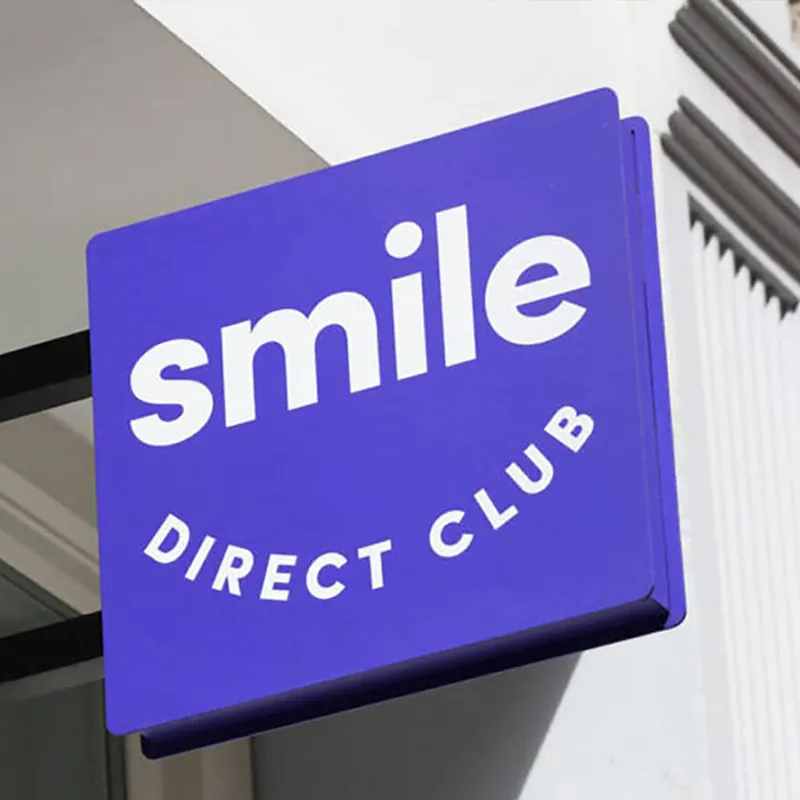 Smile Direct Club
Smile Direct Club
Doomed DIY Dentistry Experiment/Money Pit
2021: No. 18
There’s no sense in naming names at this point, so we’ll address the defunct company rather than individuals. Three years have passed since anyone from SDC appeared on this list—an eternity, really, for such a former high-flier. We all know what happened since: an unstoppable nosedive due in part to seemingly insurmountable scaling losses, leaving patients high and dry. But if you think you’ve seen the last of this perpetual ortho problem child, think again. Any enterprise with significant residual brand equity still has legs—just look at Bed Bath & Beyond, whose intellectual property alone recently sold to Overstock for $21.5 million. Don’t rule out seeing the SDC name (minus any original players) return in some form, or much less likely, some attempt at reorganization.
 Scott De Rossi
Scott De Rossi
Former Dean, Workman School of Dental Medicine
Last year: No. 9
Much speculation surrounded the seemingly sudden departure of Dr. De Rossi as founding dean of the Workman School of Dental Medicine at High Point University in North Carolina, a position he held since January 2021. The timing only added to the intrigue, coming as it did just a short time after the school’s highly publicized groundbreaking ceremony.
However, as Dr. De Rossi tells us, the “mutual decision for me to embark on a new path” was a simple case of coming full circle. “I’d already been a dean [at the University of North Carolina School of Dentistry], and I took a big risk leaving that tenured position for the chance to do something really exciting, starting this new school,” he says. “We had a tremendous amount of latitude during that phase, but as the opening approached, it became clear that I’d have far less autonomy in terms of running it day to day due to the highly centralized structure at High Point.”
We take that to mean Dr. De Rossi didn’t especially relish the idea of settling back into a more purely administrative role after several years of visionary risk-taking: attracting an impressive board of directors (stacked with several current and former 32MI), securing a $32 million naming gift for the school, establishing a network of High Point University health practices and building an innovative experience-based curriculum. Still, it’s an opportunity he’s grateful to have had, citing “the invaluable skills and insights I’ve gained [thanks to] the nurturing environment and collaborative spirit of the dental school and the team.”
What’s next? “I’m 54, and I’m at a stage where I need to give my gift away, meaning taking everything I’ve learned and paying it forward.” Without getting too specific, he says it likely means doing something more entrepreneurial, ideally at the intersection of dental and physician health care. Having successfully challenged the status quo in the hidebound world of academia, he’ll surely shake something up. We’ll be watching.
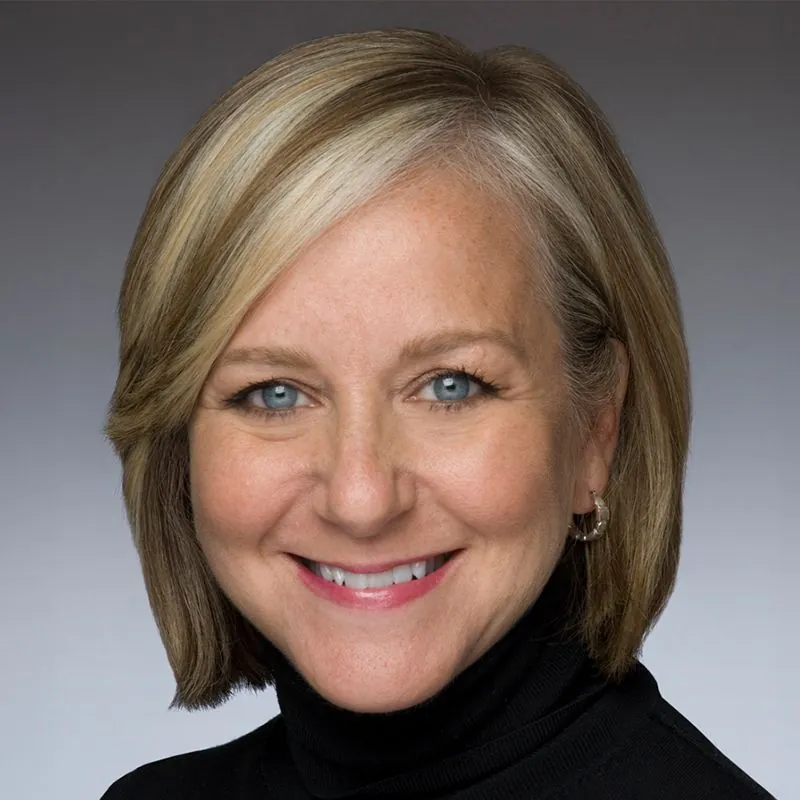 Ann Battrell (1959–2023)
Ann Battrell (1959–2023)
Former CEO, American Dental Hygienists’ Association
2020: No. 21
Battrell’s passing in June of last year was met with enormous sadness and left a void in dental hygiene advocacy. The widely respected leader was the the first registered dental hygienist and first former ADHA president to become its CEO. She first joined the organization in 2000 as manager of education and was named director of education four years later. In 2009, the ADHA’s board named her executive director, then CEO in 2016. Her accomplishments—besides leading the charge to get hygienists safely back to work during the pandemic—include expanding the ADHA’s education offerings, working to broaden dental hygiene curricula, improving access to care and advocating to widen the scope for dental hygienists to practice to the fullest extent of their education. As a result, she became, for many, the voice of the profession.
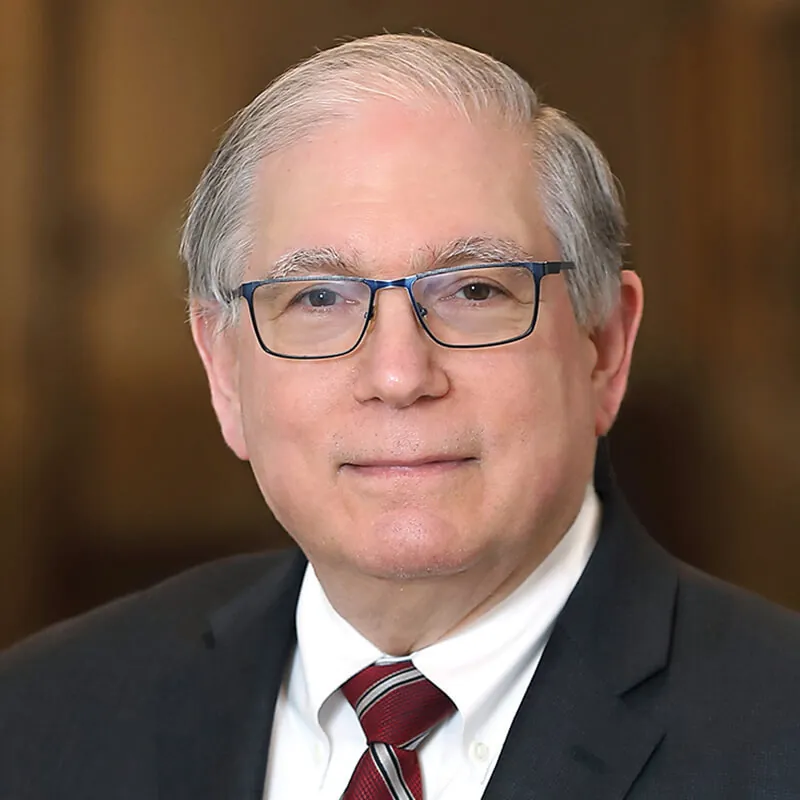
Lawrence Tabak
Former Acting Director, National Institutes of Health
Last year: No. 3
Dr. Tabak became the highest-ranking dentist in the federal government when he was tapped for acting directorship of the NIH in December 2021—a position he held until November 2023, a not inconsiderable amount of time. By all accounts, he was more than just a warm body filling the seat. The confirmation of trailblazing President Biden pick Dr. Monica Bertagnolli as permanent director—whom Dr. Tabak had voiced past support for, conceivably even playing a role in her nomination—ended his tenure. He has declined comment in the past, or the NIH has declined to make him available, which is understandable in today’s divisive political times. But he is the former policy and budget honcho of the world’s largest biomedical research agency, and we’d be remiss not to note his influence as he leaves our list and settles back into his administrative role as Principal Deputy Director and researcher. —Edward Kobesky
Benco Dental, the publisher of Incisal Edge, maintains business relationships like partnerships and distribution agreements with several firms and organizations on this year’s list, including Align Technology, DCI, Dentsply Sirona, Glidewell, NSK, Overjet AI, Planmeca, SprintRay, Solventum and Straumann. In addition, Benco Managing Director Charles Cohen is an investor in Dental Innovation Alliance.



